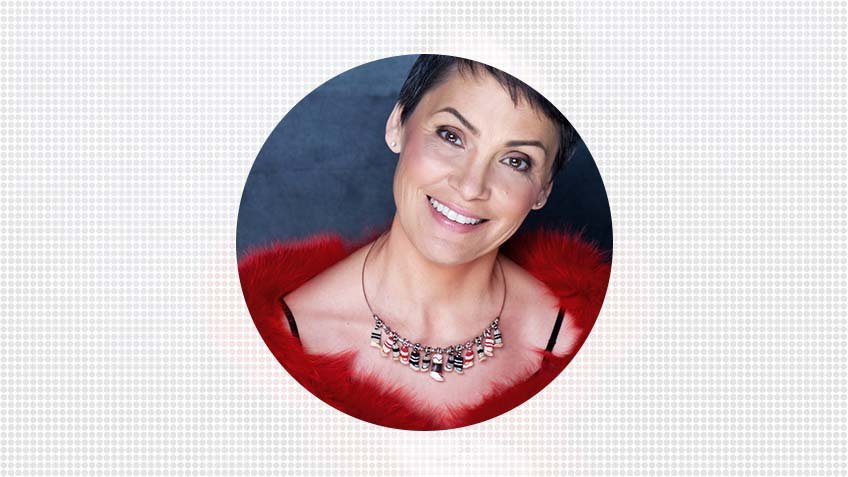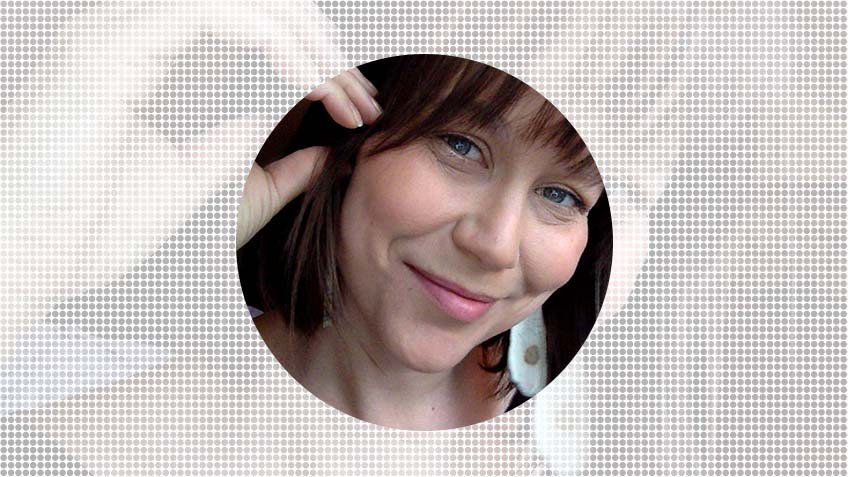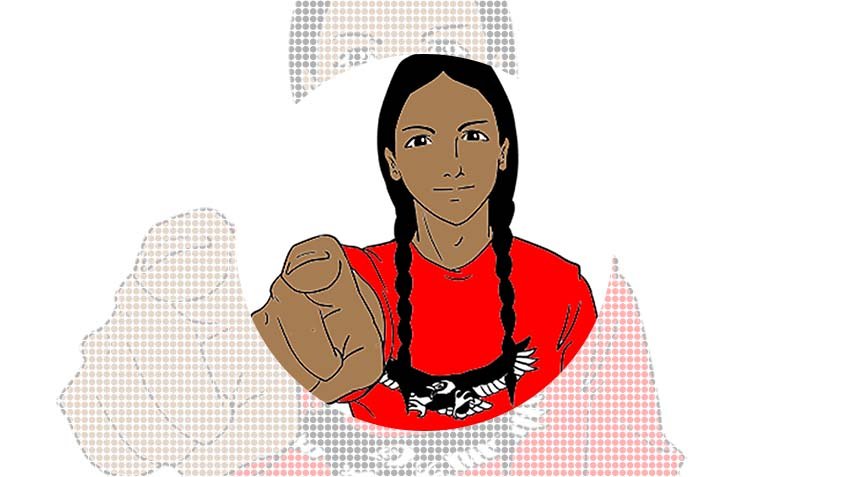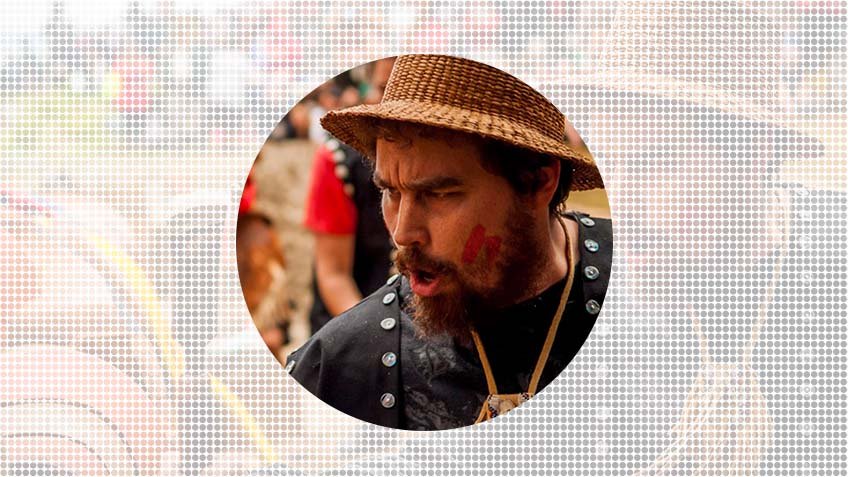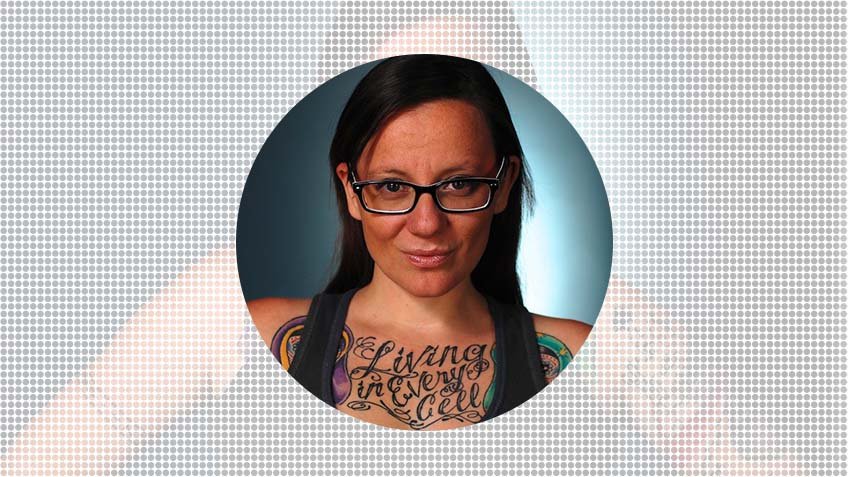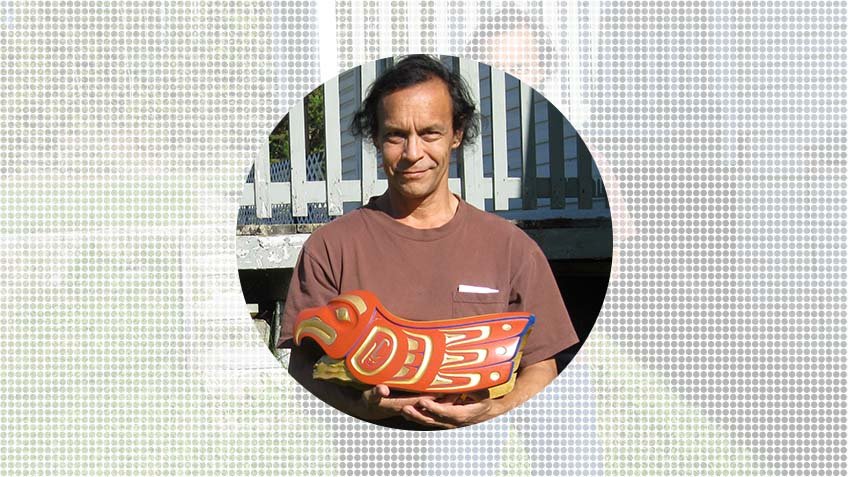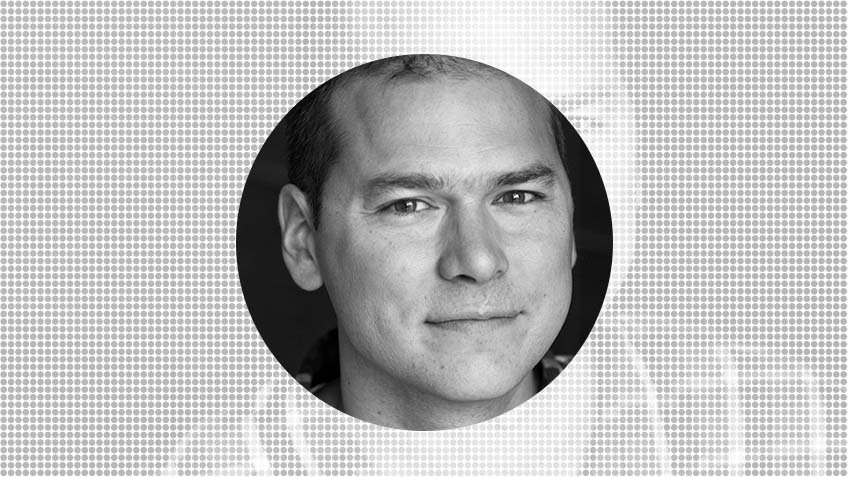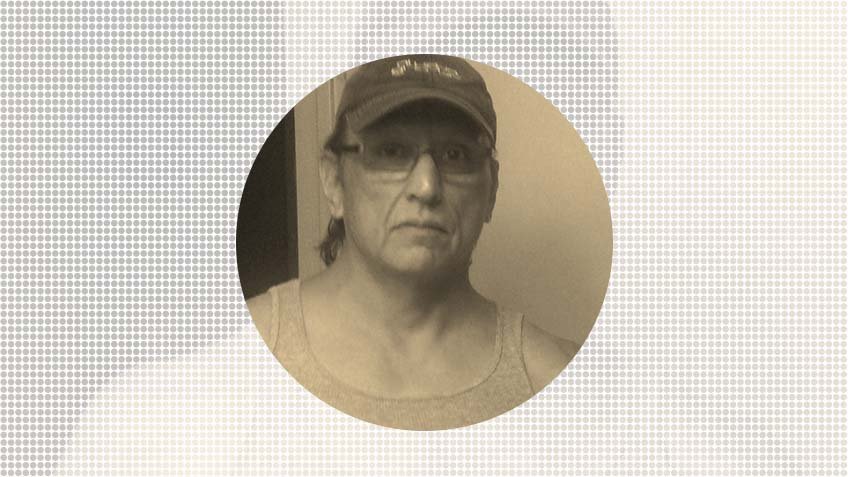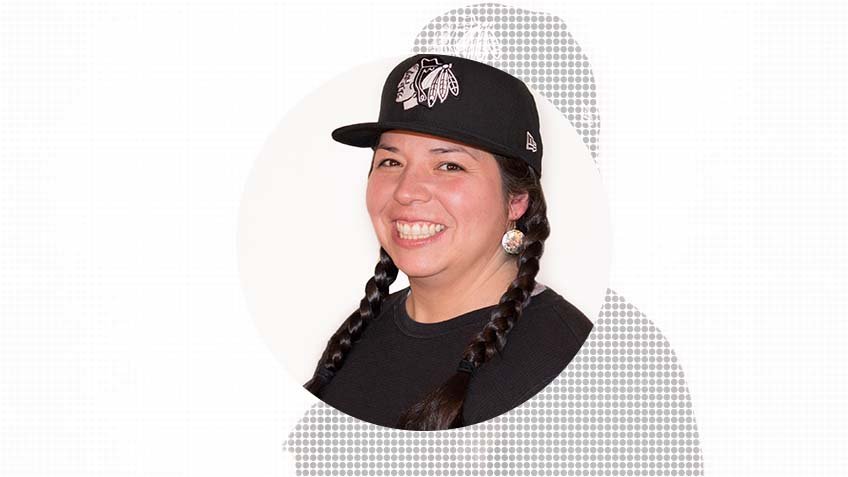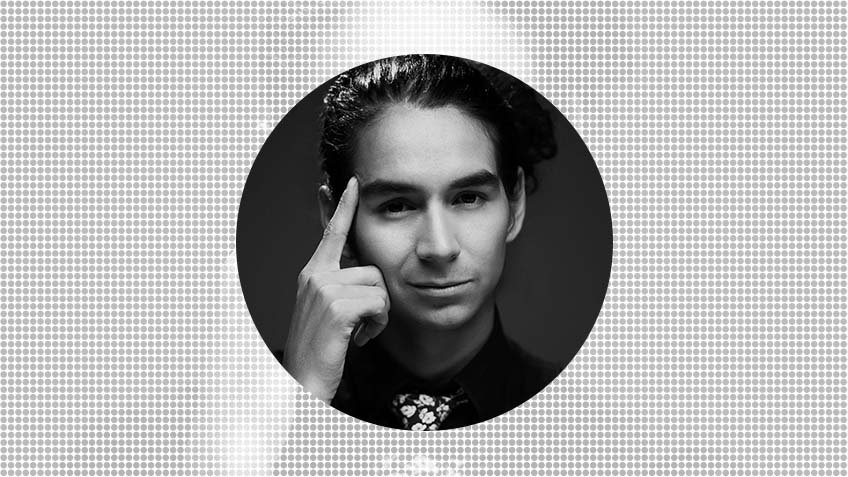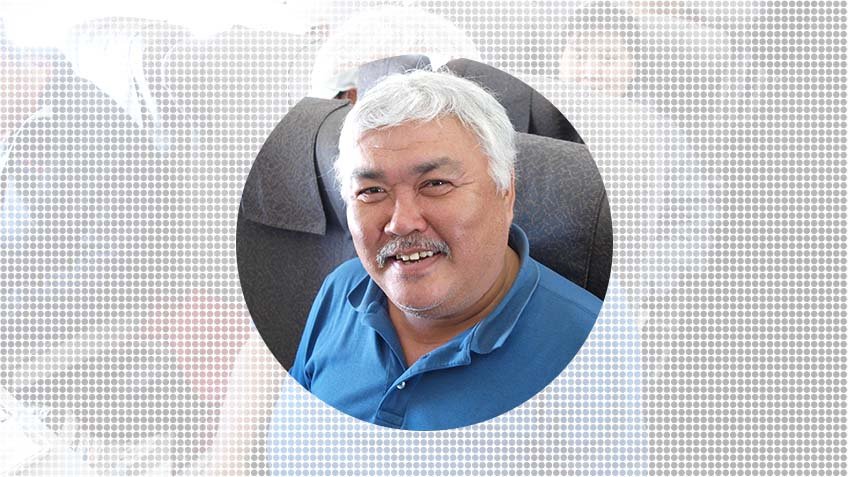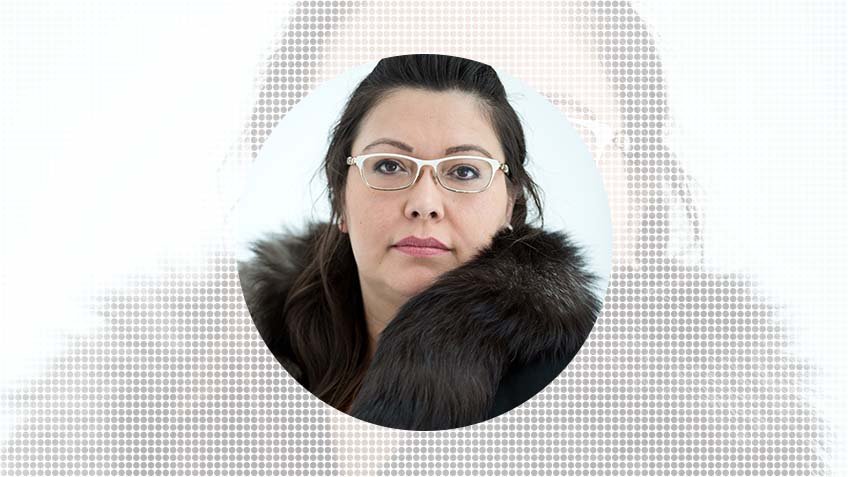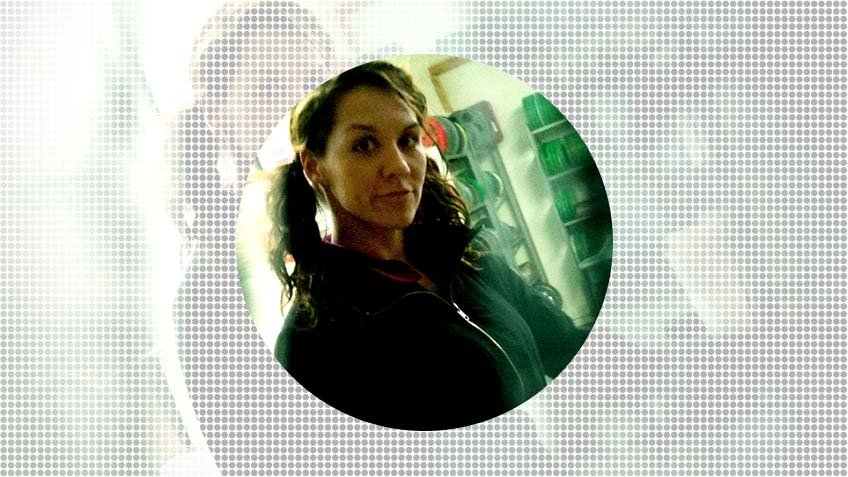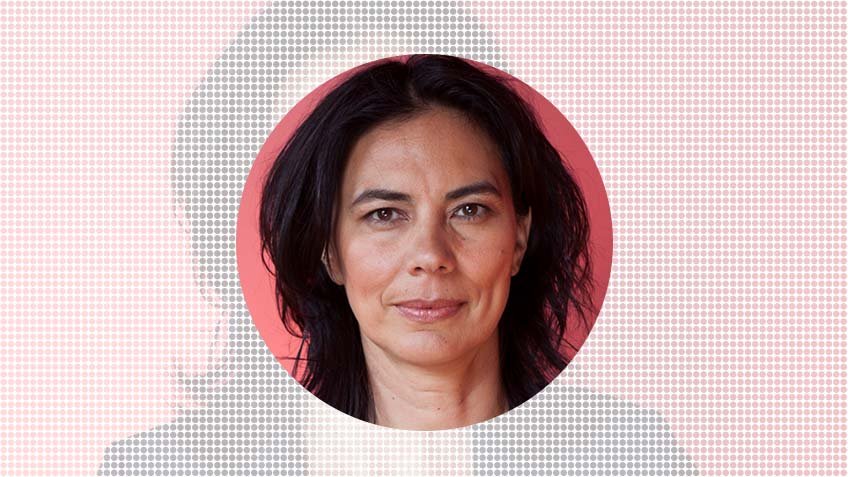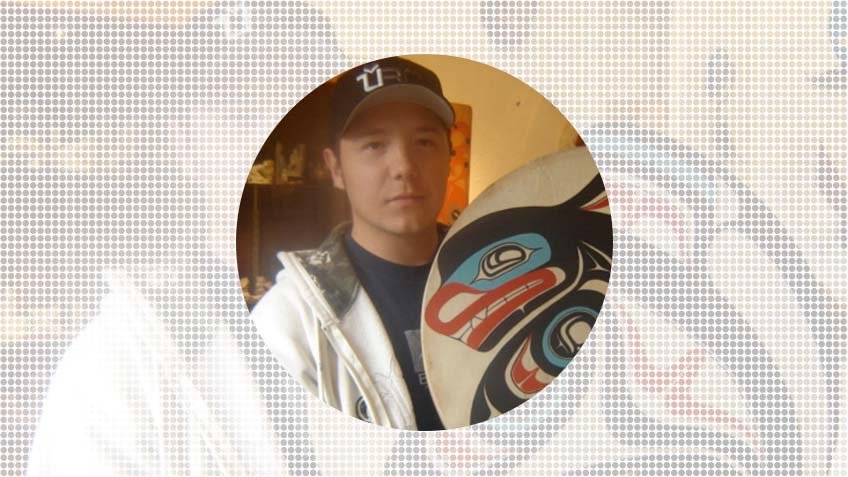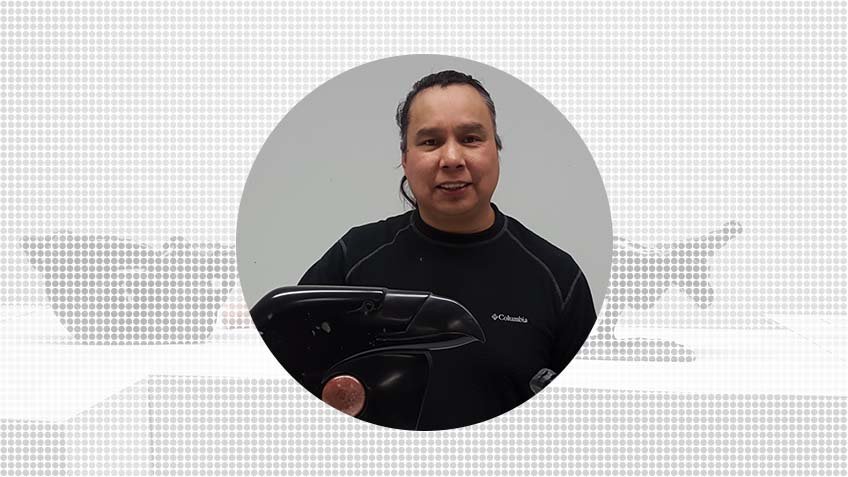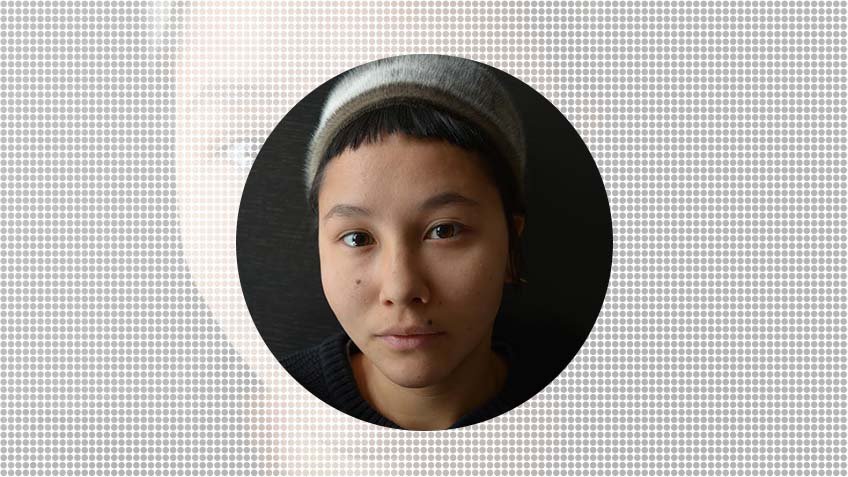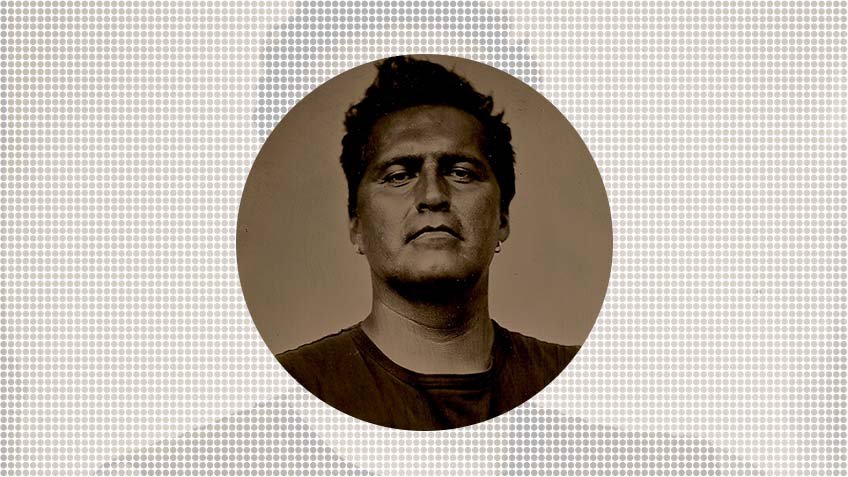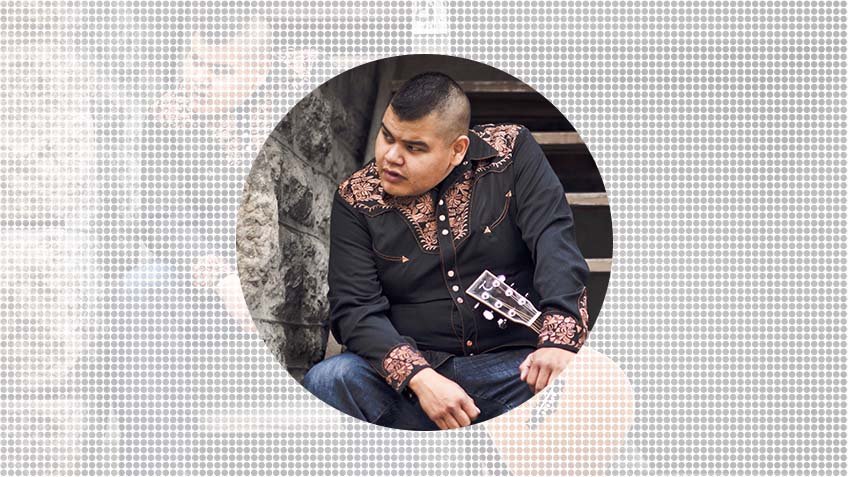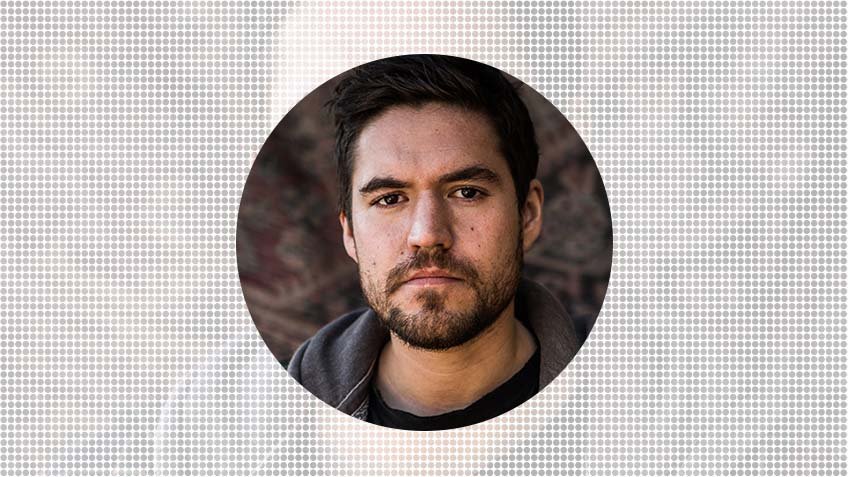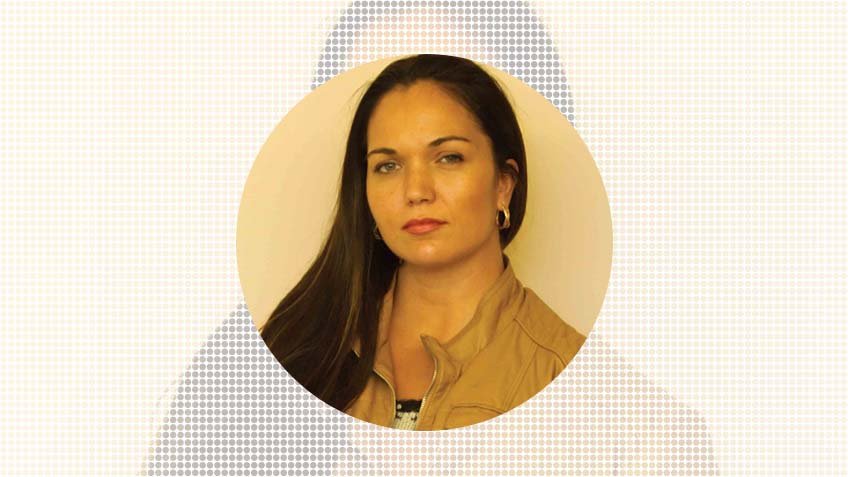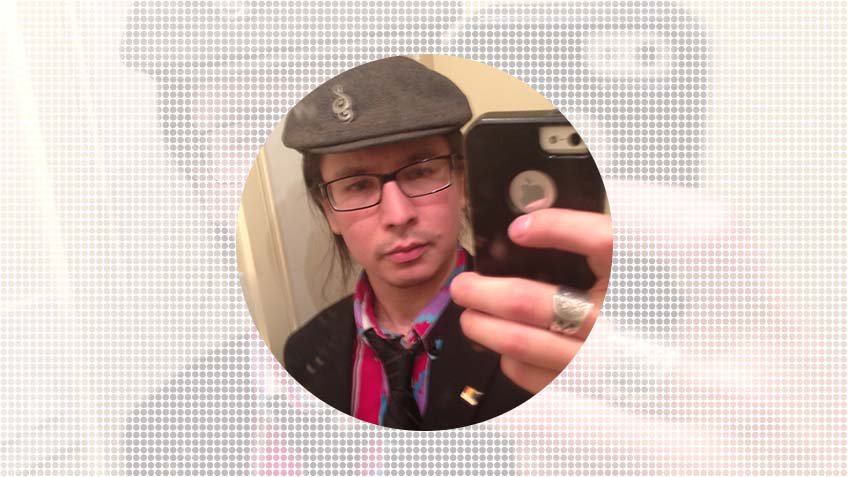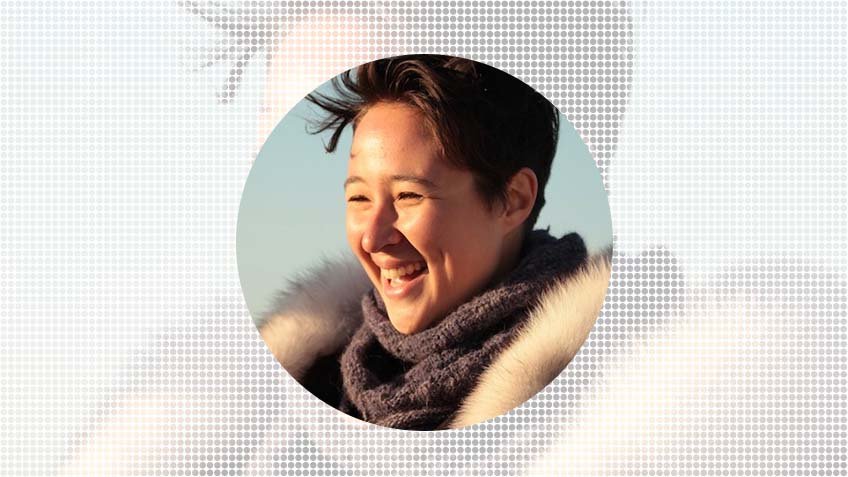PROGRAM
REVEAL Indigenous Art Awards (2017)

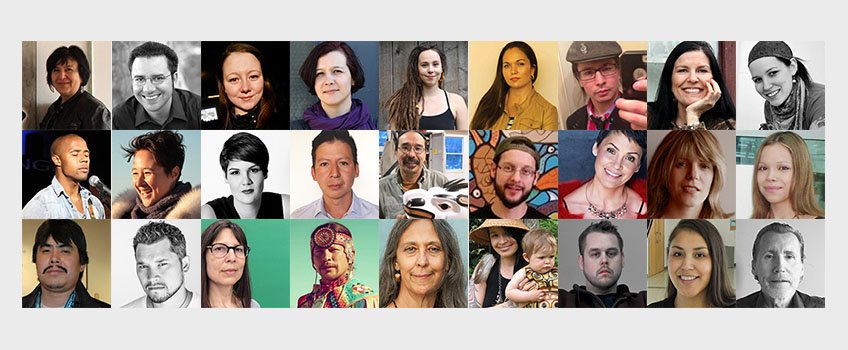
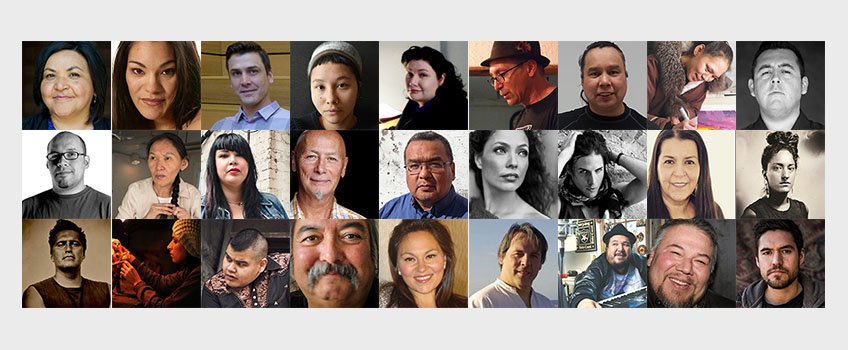
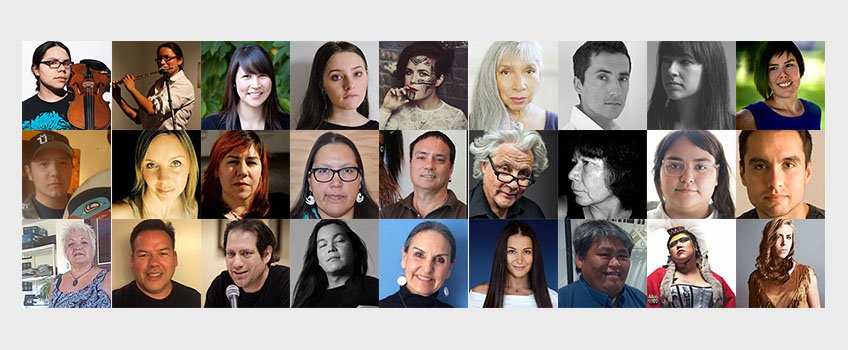
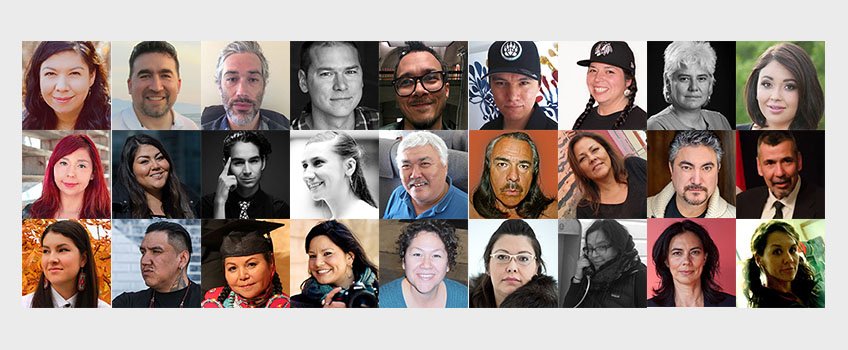
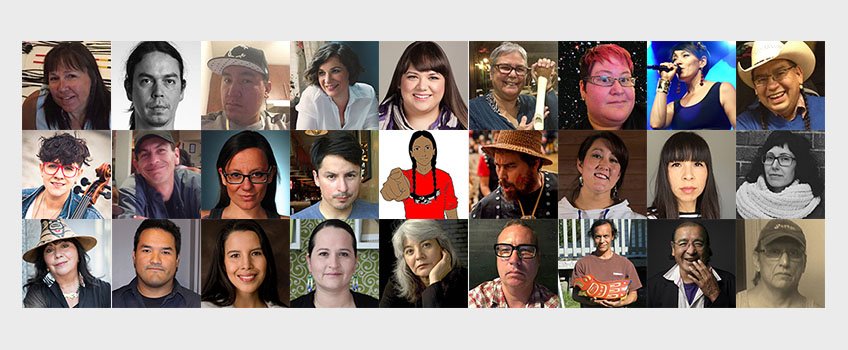
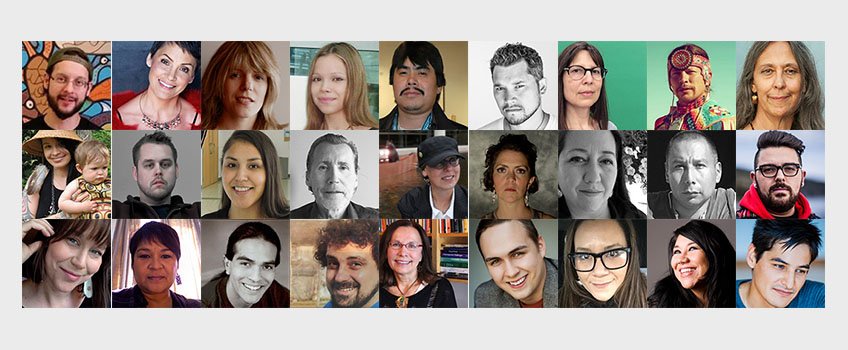
As part of its plans to increase support for Indigenous art practices, The Hnatyshyn Foundation launched the REVEAL Indigenous Art Awards to honour Indigenous Canadian artists working in all artistic disciplines. The comprehensive one-time program of awards and promotional activities, including 150 cash awards of $10,000 each awarded in 2017, have fueled the creation of new artistic works and left a lasting cultural legacy.
The Awards were intended to recognize emerging and established Indigenous artists working in traditional or contemporary practices. The awards were given in six artistic categories: dance, music, theatre, literature, film/video (media arts), and visual arts/fine craft.
A special event honouring the artists was held in Winnipeg on May 22nd, 2017.
-
Ann McCain Evans • The Hnatyshyn Foundation • The Assembly of First Nations • Shirley Greenberg • Gerda Hnatyshyn • Sheila Bayne • The Canada Council for the Arts • The Catholic Archdiocese of Ottawa • The Government of Saskatchewan • William & Shirley Loewen • Dasha Shenkman • The Stonecroft Foundation • James and Louise Temerty • Anonymous • Shelley Ambrose & Doug Knight • The Asper Foundation • Bax Investments • Ann Birks • The Bragg Foundation • Bruce Power • The John and Bonnie Buhler Foundation • Astrid Cohen • John Craig • The Danbe Foundation • The Government of the Northwest Territories • Gowling WLG • Greystone Managed Investments • Eric Jackman • Vera Klein • The Koerner Foundation • Yann Martel • Ann McCaig • Hon. Margaret McCain • Joanne and Rob Nelson • Nuclear Waste Management • James & Sandra Pitblado • The University of Saskatchewan • Todd Burke & Jennifer Block • BLP Investments Limited • Bruce & Vicki Heyman • Provincial Investments Inc. • Rob Guenette • Roman Catholic Toronto Diocese • Anglican Church of Canada • Gerry Arial • The Canadian Electrical Association • Sandra Irving • Harbour Grace Shrimp Co. Ltd • Myles Kirvan • Labrador Sea • Arnie Thorsteinson and Susan Glass • CanadaHelps • Barbara Fischer • Victoria Henry • John Hnatyshyn • Beverley McLachlin • Michael Moldaver • Maurice Panchyshyn • Rev. Gerard Pettipas • Ewa Piorko • Joanna Piorko • Nicole Presentey • Christopher Speyer • Dr. Shailendra Verma
Gifts in kind
Air Canada • Beaver Bus Lines Ltd • Fairmont Hotel Winnipeg • Office of the Lieutenant Governor of Manitoba • VIA Rail
-
Victoria Henry (Chair)
Chair of The Hnatyshyn FoundationBarry Ace
Visual artistDenise Bolduc
Creative producer, programmer and arts consultantChristine Lalonde
Curator and art historianDaniel David Moses
Poet, playwright, author and teacherFlorent Vollant
Composer, performer
-
The Honorary Patrons of this project embodied the values and aspirations of the community they represent and joined in supporting this unique initiative.
James Bartleman

Photo : Philippe Landreville
A member of the Chippewas of Rama First Nation and best-selling author of As Long as the Rivers Flow and The Redemption of Oscar Wolf, James Bartleman grew up in the Muskoka town of Port Carling. Following a distinguished 35-year career in the Canadian Foreign Service, he served as Lieutenant-Governor of Ontario from 2002 to 2007. A key initiative during his tenure was the creation of the Lieutenant-Governor’s Book Program, which saw more than a million used books collected and donated to First Nations schools. In 2008, the Ontario Government established the James Bartleman Aboriginal Youth Creative Writing Award to recognize Aboriginal youth for their creative writing talent.
Rosalie Favell

Rosalie Favell is an award-winning photo-based artist, born in Winnipeg, Manitoba. Drawing inspiration from her family history and Métis (Cree/English) heritage, she uses a variety of sources, from family albums to popular culture, to present a complex self-portrait of her experiences as a contemporary aboriginal woman. Her work has appeared in exhibitions in Canada, the US, the United Kingdom, France, and Taiwan and has been acquired by the National Gallery of Canada, the Canadian Museum of Contemporary Photography, the Smithsonian National Museum of the American Indian, and the Rockwell Museum of Western Art, among others. She has worked with grassroots organizations in Winnipeg, with Inuit educational groups in Ottawa, and with Nepalese women’s groups in Kathmandu.
James Hart

Photo : Ramsay Pictures
James Hart is one of the Northwest Coast’s most renowned artists. In addition to his mastery in carving monumental sculptures and totem poles, he is a skilled jeweller and printer and is considered a pioneer in the use of bronze among the Northwest Coast Artists. He is represented in major collections around the world including in the National Gallery of Canada, the Canadian Museum of History, and the Smithsonian Museum, and has had numerous solo exhibitions. Commissioned for the new Michael Audain Museum in Whistler, The Dance Screen is James Hart’s most ambitious project to date. As Chief of the Sangaahl Stastas Eagle Clan since 1999, he holds the name and hereditary title of his great-great-grandfather, Charles Edenshaw.
Waubgeshig Rice

Photo : Shilo Adamson
An author and journalist from Wasauksing First Nation, Waubgeshig Rice developed a strong passion for storytelling as a child while learning about being Anishinaabe. The stories his elders shared and his unique experiences growing up in his community inspired him to write creatively. Stories he wrote as a teenager were published as Midnight Sweatlodgein 2011. His debut novel, Legacy, was published in 2014. He graduated from Ryerson University’s journalism program in 2002, and has worked in a variety of media across Canada. Along with reporting the news, he has produced television and radio documentaries and features, and currently works as a video journalist for CBC News Ottawa. In 2014, he received the Anishinabek Nation’s Debwewin Citation for Excellence in First Nation Storytelling.
Please note that the REVEAL Honorary Patrons do not play an operational role with the Foundation and were not involved in the review or selection of candidates for the awards.
-
The program was closed as of June 1st, 2016.
Overview
These awards were intended to recognize emerging and established Indigenous artists working in traditional or contemporary practices. They were given in six artistic categories including dance, music, theatre, literature, film/video (media arts), and visual arts/fine craft.
Artists selected to receive an award were entitled to use the proceeds of the award at their own discretion.
Eligibility
To be eligible to apply, artists were required to:
Be of Indigenous descent.
For the purposes of these awards, Indigenous people include First Nations, Inuit and Métis people of Canada.Be a Canadian citizen or permanent resident of Canada.
Be at least 18 years of age at the time of application.
Define and describe theirself as a practicing artist.
Artistic Disciplines
Dance, Music, Theatre
For applicants in dance, music and theatre, the awards were intended for performance. Oral traditions, storytelling, spoken word, pow wow and hip hop were included in these categories. Choreographers, arrangers, composers and directors were not eligible.
Literature
The awards in literature were intended for writers in fiction, non-fiction and poetry, as well as playwrights.
Film/Video (Media Arts)
The awards in film and video were intended for creators working in film and video (analog or digital), including animation, who retain creative control of their work. Producers and screenwriters were not eligible.
Visual Art & Fine Craft
The awards in visual art and fine craft included conventional visual art practices (painting, drawing, sculpture, photography, printmaking, mixed media). Installation, performance art and conceptual art were also eligible.
In fine craft, contemporary and traditional practices were eligible, including, carving, jewellery making, ceramics, glass work, bead work, fiber, textile and fashion, and include other traditional/culture-based materials such as fish scale, caribou hair tufting, and quillwork.
Laureates
-
Nathan Adler is an emerging writer and storyteller from Lac Des Mille Lacs First Nation, Ontario.
“I am a storyteller regardless of which medium I’m working in: a painting, an audio track, a video, or the craft of writing. Stories that always seek to entertain, enlighten, and de-colonize.
Drawing heavily on my family history, Anishinaabek language, culture, and methods of storytelling, as well as historical research, dreams, intuition, and synchronism, I write mostly fiction in the Urban Fantasy and Horror genres, the sort of writing I most like to read, and I strive to write as well as my favourite authors, who tend to have a literary, gothic aesthetic, and a dark sense of humour. Stories are the best, funnest, most awesome thing to be involved in creating, and I can’t think of anything better than to be a good storyteller.”
-
Susan Aglukark is an Inuit singer from Arviat, Nunavut.
“As much as I love singing (and I love singing), and song writing, I love more the work of awakening and healing our inner selves through art and music. The process behind each album represents the places or points I am at in my personal healing journey.
My vision is to spread the power of music as a healer.”
-
Kateri Akiwenzie-Damm is a writer from Chippewas of Nawash First Nation, Saugeen Ojibway Nation (SON).
“My work is part of a continuum of artistic cultural practice including oratory, story cycles, songs, chants, invocations, poetry, libretto, stories, novels, essays, radio plays, creative non fiction, ‘experimental’ writing and multidisciplinary works. It arises from the traditions of my people, and the canon of Anishinaabek orature/literature. SON is the home territory of generations of renowned writers, orators, and storytellers including Nahnebahwequay, Basil Johnston, Duke Redbird, Lenore Keeshig and my grandmother Irene Akiwenzie.
My work is inspired by my mixed ancestry and the work of other Indigenous artists. In dispelling stereotypes and telling the truth of Indigenous realities in my own way according to concepts of truth and beauty rooted in Indigeneity and Anishinaabe culture, my work is firmly decolonial, a practice of cultural resurgence, affirmation and survivance. It rejects marginalization, centring itself within Anishinaabek creative cultural practice. My writing is inherently political, a form of activism, empowerment and resistance as well as a creative and spiritual act. Stories in my newest book, The Stone Collection, examine love and the ways in which our perceptions of people and the world around us can be misleading and incomplete. In the Anishnaabek language stones are ‘alive,’ infused with life force. Although many of the stories are about loss, under the surface they are ‘alive,’ celebrating the beauty and preciousness of life and the web of connections that join and strengthen us.”
-
Donald Amero is a singer-songwriter from Manitoba. His first four albums generated nine national and international awards, as well as a Juno nomination in 2013.
“I want to feel good about what I’m doing. With over nine years as a full time musician, I’ve come to understand that music is a business and there are certain freedoms that commercially successful artists have to give up. I don’t want to give up anything. I want to write songs that will have a positive impact on our young people. I want to work with musicians who are also great people. I want to perform in places where I’m needed. I want to have conversations with people from every walk of life. I want to sing from my heart. I want to make the world a better place. I also want to win a JUNO. ;)”
-
Judy Anderson is a mixed media artist and artisan working in Regina. She is of Cree descent from the George Gordon First Nations, Saskatchewan.
“Much of my work examines First Nation’s issues through the lens of traditional and contemporary forms of art making. My work is deeply personal with a focus on spirituality, family, and graffiti with the purpose of honoring people in my life. I have worked with hand made paper creating traditional parfleche bags, miniature burial mounds casted from my pregnant body, and a big drum. Recently I have made hand made paper clothing based upon the Spirit names of friends and families. At the same time, I have researched and learned traditional art making using traditional materials creating primarily beaded pieces. With this knowledge I fuse traditional and contemporary art forms. One such piece honours my graffiti artist son, Cruz. I have recreated Cruz’s first graffiti burner in beads on moose hide. Exploit Robe (Toying Around), the first piece in this series of four, acknowledges his inexperience as a writer while honouring the beginning of his journey as an artist. My most recent works honour Aboriginal and non-Aboriginal women where I provide space for the exploration into experiences, sensibilities, thoughts, fears, and hopes presented as female-based realities. These works include sound, beading, handmade-paper, and found objects that reveal the complexities of personal relationships. These works open the dialogue around the importance of honouring people and the many ways these ceremonies can enrich the lives of both First Nation and non-First Nations people.”
-
Joanne Arnott is a Métis writer and performer from Manitoba.
“Musicality is a primary quality of my work - the murmuring of a talking circle and the wind in the grass - whether in poetry or prose. I engage in both big picture and political matters as well as the most intimate human moments, with a personal voice that seeks to share life at the deepest levels. Topics may arise from within, be suggested by a conversation, or come at the request of an editor: whatever the motivation, I pour my best self into each glass.”
-
Cherrish Alexander is a carver from Kitwanga, B.C.
“I started my training in 2007 at Freda Diesing School of Art in Terrace BC. I was the first woman in the very first year of the program. My Instructors were Stan Bevan, Ken Mcneil and Dempsy Bob. My artwork is my life's passion; I enjoy bringing the art back to my community of Gitwangak.”
-
Joe Jaw Ashoona is an Inuk carver from Cape Dorset based in Montreal.
“I sold my first carving at the age of seven. My mother and grandfather taught me how to work with a variety of stone, petrified whalebone, mammoth ivory, musk ox horn and antler. I draw my inspiration for subject material from the time I spent growing up on the land. My memories of the Nunavummiut animals inform my carvings. A variety of which can be seen on my website.
I dedicate much of my time to making sizeable carvings ranging from 50-150 pounds each. This is my full-time occupation and one piece can take weeks if not months to complete.
Carving is the way that I perserve Inuit stories and traditional knowledge of the land, sea and animals. It is also a conduit for me to help other carvers grow their potential and become more valued by the industry for their work.
At Ashoona Arts 360, I am trying to bring awareness of the realities of the Inuit art world and how reconciliation is also needed in this domain. Through events like my most recent exhibition 20 Claws and 4 Fangs, I brought in throat singers, shared a qulliq ceremony, country food, Inuit tools and fashion and displayed my carvings to a diverse group in Montreal. I want to bring Inuit carving further by fulfilling a social mandate of public education and to work closely with other Inuit artists to achieve this.
We have many social issues to overcome in the North, but I believe that education in and the proliferation of Inuit art will help us tackle them. I will continue to carve as long as my body will allow and to devote my life’s work to the advancement of Inuit art on an international scale.”
-
Eugene Alfred is a Tutchone/Tlingit carver and painter from central Yukon.
“For me, art is always opening an opportunity to go through new experiences and to let more stories to be heard. I have been inspired by my uncles, Roger and Jerry Alfred, who in turn, learned our stories from my grandfather and other elders in our community. Increasingly, I am taking that direction with my pieces, finding my own unique experiences in my homeland.
For the past 30 years, I have been painting and carving northwest coast art. My first teacher was Dempsey Bob (Taltan/Tlingit Artist) in 1986 and I later worked with Ken Mowatt (Gitxsan Artist) for 4 years between 1991-1995. Doing native art has been a dream come true and an important way to express myself. After all these years doing northwest coast art, I am finally finding a style that I can call my own.
Receiving a REVEAL Indigenous Art Award will give me the opportunity to carve and bring back ‘dance sticks’ for our dance group Selkirk Spirit Dancers and our community of Pelly Crossing. These dance sticks were once used in our community feasts and potlatches about 80 years ago. They were taken from original home of Fort Selkirk and put into museums around the world. They were taken from our community when people were out on the land. These dance sticks are an important missing link to our past and the future of our young people. These dance sticks will be hand carved with homemade tools and use yellow cedar wood.”
-
Morgan Asoyuf is a jeweller of the Eagle Crest, Tsm'syen Nation, Lax Kwallams band, from Port Simpson, B.C.
“I create one of a kind jewelry that is completely handmade from start to finish. I use the German technique of hollow building to produce layers and shadow. Starting with flat sheet the metal is shaped and soldered. I am both a purist and an experimenter. I handmake all my tools, melt and pour metal, make my wire and sheet. I use experimental textures and construction to see how far I can bend the ideas of form. I am involved in every process of creating a piece, doing my own gem setting and stone cutting. I don't care about the time I care about the quality. About doing justice to the art form.
Always a book lover, I studied many different eras and became obsessed with Art Nouveau (Mucha and Lalique), Egyptian goldsmithing, and Hellenistic art.
Beyond my personal interest of historical art and the processes that create it, I care deeply about the forwarding of traditional Tsm’syen art and culture.
Each piece tells a story. Designs depict animal crests that tell the stories of familial rank and migratory paths over many generations. Using hand engraving for the traditional Tsm’syen forms, I then use color and textures to show different aspects of this visual storytelling.
Northwest coast art is transformative. Creating it allows me to speak in silence and feel connection to my ancestors. This is why teaching the next generations is such a huge part of my life, because this art form brings healing.”
-
Tara Beagan is a writer and storyteller of the Coldwater Band, Ntlaka'pamux Nation from Lower Nicola Valley, B.C.
“I strive to share the stories I am entrusted with, to candidly pose questions and provoke thought, thereby lessening the gaps of misunderstanding and disinterest that divide the multitude of communities in Canada and the world.”
-
Lori Blondeau is a Cree/Saulteaux/Métis artist. She holds an MFA from the University of Saskatchewan, and has sat on the Advisory Panel for Visual Arts for the Canada Council for the Arts and is a co-founder and the current director of TRIBE, a Canadian Aboriginal arts organization. Her practice includes both visual and performance contemporary art.
“My work explores the influence of popular media and culture (contemporary and historical) on Indigenous self-identity, self-image, and self-definition. I am currently exploring the impact of colonization on traditional and contemporary roles and lifestyles of Indigenous women. I deconstruct the images of the Indian Princess and the Squaw and reconstruct an image of absurdity and insert these hybrids into the mainstream. Humor is essential to my work. The performance personas I have created refer to the damage of colonialism and to the ironic pleasures of displacement and resistance.
The images of the Indian Princess and Squaw have had a significant impact on societies’ perception of Indigenous women and serve as inspirations for most of my work. Surprisingly, we still see popularized images of the Indian Princess being created by both Indigenous and non-Indigenous people. You can find these products being sold in Indian Museums and souvenir shops across North America. These are testament to the general public’s idealized perception of beautiful Indigenous women as being exotic and hard to find; virtually non-existent.”
-
Sonny Assu is a We Wai Kai visual artist working in Campbell River, B.C.
“Shedding light on the dark, hidden history that Canada continues to harbour towards its Indigenous people is a main driving force behind my work. I often use humour as a way to ease the viewer in or out of the conversations I create, and the use of autobiographical components is my way of placing a human face on the contemporary and historical realities of being an Indigenous person in Canada. Within this, I deal with the loss of language, loss of cultural resources, and the effects of colonization upon the Indigenous people of North America.
I use painting, sculpture, large scale installations, print, and photography as a way to challenge our Western civilization’s consumption culture through introspection of our consumer driven monolithic ways.
By melding Kwakwa_ka_’wakwak art, cultural and societal structures with various Western art movements, I am challenging and persisting that consumerism, branding, and technology are new modes of totemic representation.”
-
Christi Belcourt is a visual artist, Michif (Metis Nation), from Manitou Sakahigan (Lac Ste. Anne), Alberta.
“My love for this world, and my love for everyone and everything is what drives me. My paintings are a reflection of all that is right in the world, they are for me an antidote for what I see around me that troubles me. Art is one of the most powerful tools there is to try to create a better world.”
-
Kristen Auger is a fine craft artist from Bigstone Cree Nation living in Fort St. John, B.C.
“My work speaks about my experience as a nêhiyaw (Plains Cree) woman. It is an expression of the natural world and represents my cultural traditions. I strive to communicate Indigenous world views in a contemporary manner. My aim is to breathe life into the continuance of traditional Indigenous arts. I research each piece with the guidance of knowledge keepers. The designs I choose represent my culture, family and personal life. My hope is that my work will cultivate a greater awareness in society with respect to Indigenous cultures in Canada.
For my latest piece Nîpihikân Pimâtisiwin: Flower Life, I was inspired by the Cree Hoods that were first recorded in 1670 and worn by my ancestors. Generally, married women would wear them in hunting rituals or other ceremonies. Nîpihikân Pimâtisiwin: Flower Life represents my life journey. The designs emblematize periods of cultural growth. One of the flowers depicted in the piece is the wild rose as it symbolizes my cultural nation in Alberta. I created this piece during the course of my first pregnancy. I've explored the traditional roles of mothers and wives from an Indigenous perspective. This work embodies Indigenous womanhood and connection to mother nature. Furthermore, it highlights cultural continuance and the transfer of Indigenous knowledge from one generation to the next.”
-
Michael Belmore is a visual artist from Lac Seul First Nation living in Ottawa.
Born and raised in Northern Ontario, he has been a full time practicing artist since graduating from Ontario College of Art and Design in 1994. Belmore’s employment of a variety of materials and processes may at times seem disjointed, yet, the reality is that together his work and processes speak about the environment, about land, about water, and what it is to be Anishinaabe. Much of his practice has been exhibition-based but more recently he has been participating in artist residencies where he creates site-specific works that respond to the local environment.
Seemingly small things, simple things, inspire his work; the swing of a hammer, the warmth of a fire, the persistence of waves on a shore. Through the insinuation of these actions, a much larger consequence is inferred. Materials have a voice, they speak a language, and they speak to each other. Through his work Belmore attempts to join in that conversation, offering a voice that speaks about the past and the future, about our connection to this island and to its ever-changing landscape.
-
Kenny Alvin Baird is a Métis Cree visual artist from the Michelle Callihou Band, Alberta working in Toronto.
“Upon receipt of funding I will continue pursuing my current investigations with assemblage painting. After several decades of working in various mediums from installation, sculpture, film, and mixed media. I’ve come full circle, returning to my original medium of choice: painting. I believe everything is cyclical, eventually returning to its origins.
Although I have not abandoned my practice in these other areas I’ve chosen this time to focus on discovering a new creative direction by utilizing an old practice. A course reflecting present experiences without repeating any ground I’ve already explored.
I’m experimenting with the use of distressed mirror and glass over painting on hardwood with the use of animal totem iconography, like black ravens and albino wolves. The use of reflective surfacing, exampled in the work “Satellite” appeals to my interest to merge the viewer’s image, reflected in the distressed mirror with the painted image of the animal. It is a metaphor of shape shifting the human spirit with the animal spirit, incorporating both into the work as one.
This imagery, nature in beauty and decay continues to be my primary source of inspiration. It is the constant which also accompanies my attraction with polarities. I am of mixed blood heritage, Metis Plains Cree. Painting is a therapeutic emotional exercise, for me to study and reclaim aspects of my native ancestry, identity, including concepts of boundaries, both real and imagined.”
-
Jordan Bennett is a Mi’kmaq visual artist from Ktaqamkuk, Newfoundland.
“Through the processes of sculpture, painting, digital media, installation, sound installation and other mediums my work explores observations and influences from historical and popular culture, new media, traditional craft and cultural practice to convey connection to land; the act of visiting, and my familial histories. My current body of work utilizes painting, carving, projection, photography and sound to challenge perceptions of indigenous histories, stereotypes and presence with a particular focus on exploring Mi’kmaq and Beothuk visual culture of Ktaqamkuk, Newfoundland.”
-
Shuvinai Ashoona is an Inuit visual artist from Cape Dorset, Nunavut.
Ashoona began drawing in 1996. She works with pen and ink, coloured pencils and oil sticks and her sensibility for the landscape around the community of Cape Dorset is particularly impressive. Her recent work is very personal and often meticulously detailed. Shuvinai’s work was first included in the 1997 Cape Dorset annual print collection with two small dry-point etchings entitled Interior (97-33) and Settlement (97-34). Since then, she has become a committed and prolific graphic artist, working daily in the Kinngait Studios.
"When I start to draw I remember things that I have experienced or seen. Although I do not attempt to recreate these images exactly, that is what might happen. Sometimes they come out more realistically but sometimes they turn out completely different. That is what happens when I draw."
-
Mary Anne Barkhouse is a sculptor and jeweller from the Nimpkish Band, Kwakiutl First Nation, from Alert Bay, B.C., currently living in Ontario.
“I explore environmental concerns and indigenous culture through my mixed-media sculpture installations. I feel that it is critical for personal and cultural analysis on our relationship to land and how it can be improved for the future, from a political and environmental point of view.
My sculptural practice draws upon moments in colonial, contemporary and natural history to reflect on issues of sovereignty and survival. I use materials, such as bronze, porcelain, and velvet, for their associations with value, strength and authority. An example of this would be installations from the Boreal Baroque exhibition, which situate Canadian wildlife amongst furnishings inspired by designs typically produced in 18th century Paris.”
-
Jaime Black is a Metis visual artist working in Winnipeg, Manitoba.
“My work is situated in an understanding of the body and the land as sources of historical and cultural knowledge and is centered around themes of memory, identity, place and resistance. I am interested in the body/land as sites of social and political struggle, sites of memory and as vulnerable and often contested spaces. I am interested in the ways in which we can re-establish agency and resilience through interactions between the land and the body.
My most recent photo based work, Conversations with the Land, explores the relationship between the land and the body. This project involves direct interactions between the body/subject and the landscape, drawing on the traditional land based practice of Indigenous cultures. Performative acts, encounters and elements of installation combine to create images that engage with notions of Indigenous identity, evoking cultural memory by asserting cultural ties to the land. This work also seeks to ground and identify women as the central support of strong social structures (matriarchal gathering/hunting cultures) and posits a present and future where women embody this position.”
-
Nicole Camphaug is a fine craft artist from Rankin Inlet, currently working in Iqaluit.
“I have been sewing for a great number of years but have only recently been doing the sealskin shoes. I love working with sealskin and was always looking at ways to use it in a manner that promotes it and not just in the colder months. I found that people would look forward to the colder months in order wear their sealskin products. Inuit and non-Inuit who love to promote their support for the arctic and culture, seem to jump at the opportunity to wear their products. I came up with the wonderful idea of how to use sealskin anytime, anywhere.
I absolutely adore sealskin and it is very important to my Inuit culture to use it, since we eat the seal for nutrition, the fur is a byproduct, rather than the sole purpose. Inuit hunt seal to feed our families, our communities and being able to use the fur is amazing. Inuit make mitts, hats, coats, kamiit (winter, waterproof fur boots), purses, hunting bags, you name it, we will make it. I like the idea of modern shoes being adorned with sealskin, it’s another use for our furs.
As I do not make the actual shoe itself, I do like using an already made shoe, that way I am not limited to one style or size or colour. I have creative freedom to use a shoe that inspires me or challenges me. I also like that people can provide me with their favorite shoe to have them renewed, if you will. There really is no limit on what I can do with adorning sealskin to footwear.”
-
David Charette is a singer from the Ojibwe Nation, Wikwemikong unceded Indian territory, Ontario.
“My stage name is ‘White Deer.’ As I am loon clan, the creator gave me this voice to heal our nation. Loons are known for their voices. I don't just want to change the way society looks at our people but I want to heal those that need it at the time.”
-
Sid Bobb is a Sto:lo/Salish actor and writer from Seabird Island First Nation.
Combining his cultural knowledge, experience as an arts organization leader, educator and theatre artist, Sid Bobb has been committed to helping bring Indigenous stories and culture to the forefront. He is inspired by the transformative power of the rich artistic and cultural history of his Sto:lo / Métis ancestry and related communities. Sid's artistic practice is at the core of his individual, familial and nation's identity, continuity and forward vision.
Sid is the son of Lee Maracle of Tsleil Waututh First Nation and Raymond Bobb of Seabird Island First Nation. His family is rooted in a multi arts and intergenerational cultural practice. This artistic practice and knowledge transference happened in both a rural and urban context. Sid’s early experience was within a multi-generational context, with an awareness and commitment to countering the historic and continuing negative impacts of colonialism.
Over the past 15 years, Sid's artistic focus and efforts have been on strengthening the platform for children, youth and women. Historically, a Salish man's role is to uphold and support the women in their family and community. With the intergenerational impact of the continuing colonialism, breaking the veils of gender inequality and marginalization of children has been a major focus of Sid and Aanmitaagzi's efforts. This is noted in the women's focus in the narrative of their many community-engaged arts projects and the artistic roles created for, women, children and youth. For nine years he has also been host of CBC televisions award winning program, Kid's Canada. Performing for and with children is also a mutually necessary and enriching experience.
-
Celeigh Cardinal is a Métis musician from the Peace Region, working in Morinville, Alberta.
“I began singing at three months old. As I repeated a melody over and over, my mother was elated. At the age of four I sang on stage for the first time. When I was 12, I joined a choir on weekends, played piano, and started writing songs. When I was 19 I joined my first band and began performing professionally. When I was 22 I discovered I was about to embark on the greatest and scariest path I’ll ever know, single motherhood.
Though becoming a mother was time consuming and set me back as far as my personal career goals of pursing music, I quickly found that my need for more income, and the birth of my greatest muse, allowed me to get back on track. When I was 25, my son was almost three, I began playing again. I am lucky to have known my calling and to have dreams and passions from such a young age. It is a little unlucky, that it is an art form, and arts are very hard to make a living from. So, I have learned many ways to turn music and singing into a day job/night job, that allows me to support myself and my child. I have become a promoter, an open stage host, a music teacher, a social media expert, a booking agent, a pub singer, a merchandise salesman, a grant writer, and tour manager. These are all skills I have picked up in my 17 years of professional playing.
All I ever wanted was to make music the way I earn my living. I now have bigger career goals that include recording, touring, and more sustainability. Maybe even one day, medical benefits. I know I've taught my son the importance of following/living your dreams, and I am living mine the best I can.”
-
Christa Couture is a Cree and Métis musician from the Prairies living in Toronto.
“Everyone is looking to feel less lonely. The focus of my work comes down to the conversation that happens between performer and listener. In that exchange, I feel both sides are asking the question ‘Do you know what I mean?’ searching for and finding common ground and connection between open ears and hearts.
My work draws on loss, grief, illness, longing, survival, and resilience through writerly, at times even playful, skill with words. Through songs, I share what comes next after loss, what comes after you pick up the pieces, and how to find hope in the shadows of our harder, complex human experiences.
My practice is contemporary music that at its core is Indigenous culture: conversational, autobiographical work drawn from my personal experiences; experiences that reflect my intersecting identities as a Cree woman and woman with a disability (or halfbreed and cyborg as I choose to identify), as well as a mother and artist. Until the studio recording process, nothing is written down: my work is created, learned, and shared as a practice of aural/oral tradition.”
-
Ludovic Boney is a Huron/Wendat visual artist working in Lévis, Quebec.
Boney's minimalist formal research integrates the constraints of the material into the concept of his works. His sculptures take on the appearance of aesthetic structures, with planes and solids giving way to lines and voids to signify the creation of new spaces: intimate and discreet. In this way, the interiority of the sculpture becomes increasingly important, to the point of sometimes confusing the essence of the work and its influence on its surroundings.
Since it's the atmosphere of a place that inspires him, his sculptures are always imbued with it, integrating harmoniously with idiosyncratic aesthetic references. Industrial mechanics, and the noise they produce, are elements he incorporates into his research, development of form, choice of material and elaboration of concept.
From these juxtapositions emerges a powerful, vibratory effect of unity. The forms he creates are voluminous, and their robustness is invariably contrasted by a disturbing impression of precarious balance that prompts the viewer to question or contemplate.
Boney is deeply attracted to public art, that is, "art that is accessible to the users of our parks, streets and cities". Most of his creations are designed to be understood by the lay public as well as by art insiders (craftsmen, visual artists, engineers and architects).
-
Cliff Cardinal is an actor, writer and singer from Pine Ridge working in Toronto.
“I’m an Urban First Nation’s person. I’m constantly an outsider. This perspective has shaped the stories I tell and write and songs that I sing. I grew up in urban centers feeling Indian and loving Indian, but not having a constant connection with others who share spiritual practices. Most of my work is not culturally specific. The cultural references are general to being ‘Indian,’ as opposed to a specific First Nation. My work is usually set in Toronto or some generalized city, town, or reserve. I find myself fascinated by stories and songs about marginalized people.
Poetics is a life-long endeavour. Each project has been challenging, heartbreaking, and elating; and has given me the opportunity to challenge myself to take on a new aspect of poetry. I write about what scares and embarrasses me. I explore pain and what I’m ashamed of; and I go there with love.
Things are bad; but everything’s going to turn out alright after all. I’m haunted by how much of our culture and how many of our stories and people were stolen. My poetry attempts to create meaning and beauty from heartbreak and loss. Stylistically, I steal from different mediums and moments in my life to create new myths. The time we spend together in our brief walk on earth is sacred, and worth telling stories and singing songs about.”
-
Francine Cunningham is a Cree author from Saddle Lake, Alberta.
“I entered storytelling through theatre and from there fell in love with shaping experiences for an audience and the power that speaking truth can have. I studied creative writing and theatre throughout my BFA at The University of British Columbia. During my MFA at UBC, I pushed myself to learn as much as possible about the writing craft from many writers. While studying I wrote a young adult novel which features a young Cree Métis girl named Sage who struggles with mental illness and follows her journey to healing after an attempted suicide. The project that I am currently working on it titled The way I was brought into the world was this and is a non-fiction memoir that looks at trauma and how it affects a person’s genetic tags and influences mental illness by exploring the research surrounding epi-genetics. Specially, it is exploring the intergeneration effects of the systemic policies of abuse, assimilation and attempted genocide against the First Nation’s people of Canada. By exploring these effects in one family, my memoir hopes to add to the ongoing conversation surrounding reconciliation. I am striving to bring my own experiences with being a Cree Métis woman who grew up in an urban environment to the conversation surrounding Indigenous issues. I would like to see in literature more stories that reflect the growing urban Indigenous population and our unique lens. I’ve worked with urban Indigenous youth for ten years and know they’re looking for characters that reflect their lives.”
-
Rita Bouvier is a Métis writer from Saskatoon, Saskatchewan.
“I love writing! In my writing, I strive to balance ‘a good story’ with sound and images drawing on both my first and second language. I often play with the meaning and musicality of both languages as a way of connecting with others and to the Great Mystery. I love the power of leaving a still-life image on paper with my choice of words and space as silences. Likewise, I balance personal experience, response and observation with imagination to transcend the material and imaginative failures of our time. I do so by remembering knowledge passed down to me, by dreaming, by gathering strength and reconciling what has happened and is happening in our communities and to the natural environment, and by rejoicing in the life around me. I often find myself returning to place and to the sounding – the music of our mother's movement and voice.
My writing reflects everyday life in the communities I am a part of, because it is sacred. I strive to find the spiritual core of life and living; although, I am sometimes filled with an immense sense of loss, shame and longing. Of course, I have also found beauty and joy. Through my writing, professional and creative, I try to tell a larger story, one that is filled with love for family, community and this place I know. Like my ancestors, all I can be is in awe of her power. Humbled.”
-
Liz Carter is a mixed media artist from Alert Bay.
Not being able to settle on one medium, Carter creates work using an array of mixed media. Her journey through the labyrinth of mixed meanings embedded within her Native ancestry and her blue-collared upbringing is driven by process. She uses culturally significant materials like wood, copper, buttons, and animal skins in new ways- with hints from the past and questions about how cultures are interpreted.
Carter’s displacement from her cultural roots has had a profound effect on her work as an artist. She explains, "it’s a life riddle" that has taken her upon a biographical journey full of unanswered questions about displacement and loss of tradition. Carter's search has uncovered a realm of commercial images of the 'Imaginary Indian' that profoundly impacts our perception. It has also revealed the determined struggle of Kwakwaka'wakw culture to carry forward ancient symbols and meanings into a contemporary life.
-
Raes Calvert is a Métis actor, producer, and director based in B.C.
“I first began performing on stage while I was attending high school in Richmond. I was drawn to theatre performance because it allowed me the opportunity to be present and live in the moment (something that is sorely missing in the day to day lives of those living in the ‘Western World’). At the age of seventeen, I decided I would pursue acting, but more specifically performance in theatre, as my life's work. I attended Studio 58 at Langara College where I received my Diploma in Performing Arts. During my time at Studio 58, I realized what an amazing platform live performance is. Theatre has the power to incite critical thinking, create public discourse, and affect social change, (not to mention, it's also a lot of fun!).
In January of 2010 I co-founded a theatre company, and began creating and producing my own work. Through my experiences as a theatre creator I began to shape myself as an artist and decipher what live story-telling means to me. Creating a company has given me the chance to work, not only as a performer, but also as a designer, a director, a writer, and as a producer and theatre administrator. Being an indigenous story-teller has given me the incredible opportunity to connect to my aboriginal heritage, network with other First Nations artists, and use my art form as a means of cultural exchange.”
-
Christian Chapman is an Anishinabe visual artist from Fort William First Nation.
“I make art because it’s my way of paying respect to the past by way of telling a visual story. Storytelling is very important to me. Stories of heritage, identity and personal experience are explored in my art. The oral tradition of storytelling is important to the preservation of the evolving Anishinabe culture.
I like to think my art helps keep stories alive for future generations to come. I remember the stories my grandmother would tell. She would tell stories deeply rooted in family history and background. Whether it’s a story from my grandmother or from my father, stories come from all over my community and beyond. I use these narratives to create my images. I hold the highest regard for storytellers. A good storyteller can evoke tears and laughter.”
-
Beatrice Deer is an Inuit/Mohawk musician from Quaqtaq, Nunavik.
“Music is something I consider a part of me. I use it to express myself, express my love for my culture, my personal experiences and messages that I feel would help someone in some ways. I like to contribute to Inuktitut music. I like to incorporate traditional Inuit throat singing to my contemporary music, as we are an adaptable people to modern times. Music can touch people no matter what language we speak. It speaks for those who can’t speak for themselves. I love to show my culture through my performances by singing in my language and wearing traditional/contemporary clothing I have created, or wear Inuit made accessories on stage. I like to show the rest of the world that we are just as talented as the rest. I also focus on being an example to youth about living a healthy, sober lifestyle.”
-
Wally Dion is visual artist from Yellow Quill First Nation, Saskatchewan.
“A large part of my studio practice has included the use of recycled computer circuit boards. Instantly recognizable around the world, circuit boards are the hieroglyphics of our time. For many people, computer circuitry is as enigmatic as the symbols carved into the side of a 3000 year-old temple and yet we have enormous faith in their ability to furnish us with our lifestyles.”
-
Tara Gereaux is a Métis writer from southern Saskatchewan.
“My earliest childhood memories are of my mother teaching me to read, and of trying to write my own stories – and all of this before I started school.
Writing is how I fit into the world. It’s who I am. I didn’t learn of my Métis history, however, until I was an adult, after I began publishing and producing my work. Though my first book was published after I began exploring my Métis culture and identity, it had been written and accepted for publication before I started reconnecting with my heritage.
Now, my writing and stories explore this discovery, and the choices that some people make to either steadfastly maintain their Métis identity against opposition, or to conceal it (if they can). Why choose one over the other? How does such a choice impact lives? I am fascinated by this. Why do some choose to be part of the culture, and some hide from it?
My writing also explores all the challenges that come with identifying as Métis later in life – the responsibility to the community and culture, the guilt of not having been raised in it. How Métis can someone be if raised White?
But I am also gripped by the joys of this new connection (to the past and the present), and by the strengths of knowing more about who I am and where I come from.
I fit into the world through my writing, and I now use writing to fit into the world as Métis.”
-
Treffrey Deerfoot is the Artistic Director of Blackfoot Medicine Speaks Dance Company and well known beadworker from the Siksika Nation and Blood Tribe of the Blackfoot Nation, Alberta.
“In Alberta and Saskatchewan, I am a well-known pow wow dancer, speaker and ceremonialist. I am a member of the sacred Horn Society of the Blackfoot people and a partner to a sacred "Beaver Bundle". I am strongly committed to preserving and transferring our way of life for and to younger generations.
Since the age of 4 I have been a dancer. At a young age I learned to bead from my grandmother whom was my primary caregiver. I have beaded and designed many numerous Blackfoot specific outfits for myself, children and grandchildren. As a result, my beadwork and outfit making has been commissioned by many fellow dancers. Presently I have complete outfits at the Royal Alberta Museum, Glenbow Museum, Calgary Airport, and Blackfoot Crossing Heritage Park.
My beadwork and outfits are true Blackfoot designs. Today many talented younger generation beaders and crafts people, bead beautiful generic pan-indigenous designs without a true understanding of the stories, traditions and knowledge of origins. Unfortunately, designs are taken from the internet and incorporated into many outfits and beadwork. In comparison, my family designs are congruent with the designs found in daguerreotype photos of our people. While one individual cannot stem the loss of culture, it is my hope that my work will stand as testament to what true Blackfoot design is in the modern world.”
-
Jason Eaglespeaker is a graphic novelist of Blackfoot and Duwamish descent living in Calgary.
“Indigenous art has been a part of my life since birth. My grandfather, the late Glen Eaglespeaker, was a renowned multimedia artist that traveled the world with me as a young boy. Today, my works draw upon the timeless teachings he passed onto me. One aspect of Indigenous life I felt wasn’t represented in art are traditional values (respect, humility, truth, bravery, honesty, love and wisdom). Sincere traditional values are the basis of culture, so as a result, I have always concentrated on showcasing their strength.
My graphic novel approach gives me the freedom to address aspects of Indigenous life that do not get proper attention (poverty, cultural “sellouts”, addictions, racism, unemployment etc). The graphic novel medium is truly innovative and allows me to fully express my artistic concerns, in the most traditional way of my ancestors - storytelling.
I've witnessed, first-hand, the destruction and trauma that resulted from residential schools and the horrific government policies which existed for all Canadian Indigenous people, all the way up to the 1980s (some schools were still open in 90s). From my great-great-grandparents, right up to my aunts, uncles and parents, residential schools have impacted those well beyond just survivors. This too, is reflected in my works.
My preferred art methods are graphic novels and comics (digital and print), pastel, watercolor, social media, interactive web design and smartphone applications - with a dual goal of revealing Indigenous-based values and enhancing awareness of contemporary/ traditional Indigenous issues.”
-
Dorothy Grant is a Haida fashion designer living in Tsawwassen, BC.
“I am a fashion designer and traditional Haida artist. For over 30 years, my Haida identity has been my foundation as a contemporary fashion designer. In 1986, I became the first to merge Haida art and fashion
I believe my clothing embodies a philosophy that is best described in a Haida word: YAANGUDANG, which means having “self respect for one’s self and others”; this is the driving force behind my work. For me it is about empowerment, pride and feeling good about oneself.
I believe my ability to maintain a quality line of clothing for 30 years, and remain true to my artistic ability has been one of my best achievements. I believe I’ve also helped in influencing in a positive manner many younger emerging fashion designers of native ancestry throughout Canada, The United States and New Zealand.”
-
Cris Derksen is a musician from the North Tall Cree Reserve, Treaty 8, Northern Alberta.
“I think this is a compelling time for Canadians as the lens towards First Nations folks has begun a shift towards understanding the colonial impacts our collective history shares. By fusing the European classical idiom with Traditional Powwow music I have created a vessel for the classical music community and the Indigenous community to meet equally and build new relationships.”
-
Jaalen Edenshaw is a Haida carver from Haida Gwaii, B.C.
“As a Haida person, my life’s work is to learn from my elders and ancestors and carry forward our culture, language, and relationship to the land. My work as an artist is rooted in this understanding and intention. The pieces I design and create all play a role in this process of experiencing, learning and sharing. As I work, I draw on the lessons that have been left to us by our ancestors in order to tell the stories of our land and people. Many of our ancestral works now stored in museums, or still standing in the ancient village sites around Haida Gwaii, show their artists’ mastery in their carving and painting, a mastery that represents centuries of refinement from the experience of living connected to the land and the sea.
While mainstream art may be divided into ‘modern’ and ‘traditional,’ our Haida tradition is alive and continuous, transcending this division. The thread we carry forward in our arts, songs, dance and story is without end and continues to gives shape to our past, present and future. Inseparable from my practice as an artist, I hunt, fish, gather seaweed, cockles and scallops, and process all of it to feed my family throughout the year. Continuing these practices allows me to connect with the essence of the shapes and forms of Haida formline design: a fish’s eye, the joint of a deer's leg, or the stem of a blade of sea grass.
The rules of Haida art that I have spent my life learning, in mentorships with Guujaaw and Jim Hart, and in my own work, guide my explorations of flow in formline, ovoid, and U. Within the intricacies of these visual and tactile rules, I have learned to play with forms and have conversations with the pieces left to us by past artists.”
-
Phil Gray is a carver of Ts'msyen (Tsimshian) and Cree First Nations descent living in Vancouver.
“I started carving at the age of 15. Early on, I had a few teachers to guide me. But it wasn’t until I began to study the old pieces of my ancestors, paying close attention to the Ts’msyen style, that I came into my own. While I have been viewed by many colleagues as a contemporary artist in my field, I consider myself a traditional artist following the old Ts'msyen ways.
But because my art is an expression not only of my heritage but also of my experiences, I have referenced pop culture from my childhood in some of my pieces. In addition, I have traveled to many countries around the world, and I have found a great deal of inspiration from the artistic traditions I encountered.
However, I believe that inspiration and artistic talent can only take you so far without something else that drives you to stay passionate and evolve artistically. When I first started out, it was fear that drove me. I spent the majority of my time trying to improve, trying to overcome my fear of not knowing my place in the art world. Frustration followed. I was frustrated that my potential wasn't obvious to everyone and I felt that I wasn't as good as my artistic contemporaries.
These days it's humility. I realize that creating art is not a race, that there will always be something else to learn, and that I can also teach others. Humility has rekindled my artistic passion as of late, and I've become driven to focus more on giving back to my people, sharing and passing on the knowledge that has been gifted to me over the years. Above all, I want to be remembered as a dedicated Ts'msyen artist.”
-
Ruth Cuthand is a visual artists and bead worker, Plains Cree, from Little Pine First Nation, Saskatchewan.
“Beads and viruses go hand-in-hand; new diseases and goods that traders brought to the Americas. I am alarmed by the contaminated water issues that are faced by many First Nation communities across Canada. I have beaded magnified bacterium and parasites that are found in the 94 First Nations that currently have boil water advisories. I have put these into resin inside glasses of all sizes.”
-
Todd DeVries is a Haida weaver from Skidegate.
“In 1999, I had a vision of the grandmother of the forest. At first I wasn’t sure who or what she represented, but after taking a hike through a cedar tree forest, I realized that the trees themselves are the grandmothers and learned a song/prayer to thank the spirit of the cedar, long life maker.”
-
Deantha Edmunds-Ramsay is an Inuk singer from Nunatsiavut, Labrador.
“There is a fascinating history in Nunatsiavut that goes back in time to the Moravian missionaries who travelled to Labrador from Europe centuries ago. They brought violins, cellos, trumpets, horns, and more. They also brought manuscripts of the music of famous German composers such as Handel and Haydn, as well as lesser-known composers of the Moravian faith. The Labrador Inuit learned to play various instruments of the orchestra, translated the lyrics into Inuktitut, and sang some of this beautiful music in 4-part harmonies at church each week. The Inuit made it their own.”
-
This bio was updated in 2024.
Theo Jean Cuthand is a filmmaker of Plains Cree and Scots descent and a member of Little Pine First Nation. He currently resides in Toronto, Canada.
Since 1995, Cuthand has been making short experimental narrative videos and films about sexuality, madness, Queer identity and love, and Indigeneity, which have screened in festivals internationally, including the Tribeca Film Festival in New York City, Mix Brasil Festival of Sexual Diversity in Sao Paolo, ImagineNATIVE in Toronto, Ann Arbour Film Festival, Images in Toronto, Berlinale in Berlin, New York Film Festival, Outfest, and Oberhausen International Short Film Festival. His work has also exhibited at galleries including the Remai in Saskatoon, The National Gallery in Ottawa, the Whitney Museum of American Art in New York, MoMA in New York, and The Walker Art Center in Minneapolis. He completed his Bachelor of Fine Arts majoring in Film and Video at Emily Carr University of Art and Design in 2005, and his Masters of Arts in Media Production at Toronto Metropolitan University in 2015. He has made commissioned work for Urban Shaman and Videopool in Winnipeg, Cinema Politica in Montreal, VIMAF in Vancouver, and Bawaadan Collective in Canada. In 2020 he completed working on a 2D video game called A Bipolar Journey based on his experience learning and dealing with his bipolar disorder. Currently he is finishing his second video game Carmilla the Lonely, a lesbian vampire game about ethics. He has also written three feature screenplays and has performed at Live at The End Of The Century in Vancouver, Queer City Cinema’s Performatorium in Regina, and 7a*11d in Toronto. He is a Whitney Biennial 2019 artist. He is a trans man who uses he/him pronouns.
“I didn’t originally intend to be an experimental filmmaker. My work is largely dealing in a DIY aesthetic due to the very real experience of normally living in poverty. Experimental works are less costly for me to produce. If my actors are all pipe cleaner dolls, or if I am jumping around performing in a baby doll dress, or if I am delivering a lecture in front of a green screen with some footage of dandelions behind me, crucial messages can still be conveyed humorously and poignantly without the need for things like grants or patrons” (2017).
-
Cherie Dimaline is a Métis writer from Georgian Bay.
“I write literary fiction that speaks to a global audience from a very specific Canadian Indigenous perspective. My work delves into issues of identity, loss, ties and the severing of such, anxiety and the attempt to live with normalcy in an unnatural world. Through each story are the voices, stories, teachings and lands of my Anishnaabe and Métis grandmothers.”
-
Melissa General is a Mohawk/Oneida media artist from Six Nations of the Grand River Territory.
“My practice is heavily influenced by my Haudenosaunee identity, history, community and my relationship to the land. My artistic mission is to continually research and explore Indigenous history and culture, through photo, audio, video, language and performance; to further experiment ways of making in order to evolve my practice forward; promoting the knowledge and discussion of Haudenosaunee identity, culture and history.
I began primarily as photo-based artist with my practice expanding to include video and audio installation based works. My work is performative, exploring concepts of memory, history, land and Indigenous identity; discussing the notions of belonging and negotiating the intersection between urban life and ‘home’.
I maintain a strong relationship to my family and home community with the majority of my work produced on Six Nations Territory. My practice reflects my personal progress of understanding and recognizing my Indigenous identity through research, experience and exploration using my Indigenous body to address issues of identity, memory and land. I hope to continually expand this knowledge through my practice by further researching both my personal and community history and by developing my knowledge of Indigenous language to further discuss history, identity and culture from a Haudenosaunee perspective.”
-
Louise Halfe is a Cree poet from Saddle Lake, Alberta.
“I am a Cree poet, writer and author of four books of poetry and have been published in various anthologies. The books are as follows: Bear Bones and Feathers, speaks to the residential school impact on the community as well as of personal nature. The book also addresses the teachings of the old people and what still needs to be preserved. There are also letters of retaliation to the Vatican. Blue Marrow is a book of imagined relations with the newcomers as told through the various voices of imagined aboriginal women of the fur trade era. The Crooked Good is a narrative poem of the sacred legend of the Rolling Head. It is told through the voice of the mother who weaves the story from a Cree feminist perspective. Burning In This Midnight Dream was written after the Truth and Reconciliation events took shape throughout the country. The book is written from the personal thereby more intimate and immediate. It addresses lateral and horizontal violence though none of this sterilized jargon is utilized rather they are stories that have shaped history and the personal lives of residential school survivors.
I write these stories in hopes that it will help others to articulate the violence that has been perpetrated in their lives; shame, guilt and anger are braided and have a powerful hold on a person. It is my hope in sharing these stories in a poetic voice that more people will step up and demand from the government the resources that are needed to educate and help our communities heal. These poetic stories also record some of the untold history of the ancestors; these stories are fast disappearing as our Elders are fewer in numbers. The Canadian public as well need to be educated about the policies that we all inherited; these have silenced and crippled our communities. We all have a responsibility not only to share the history but to do something about it. This is my way of contributing to hope and to awareness.”
-
Tasha Hubbard is a filmmaker from Peepeekisis Cree Nation living in Saskatoon, Saskatchewan.
“My film and media work comes from my own desire to reconnect to my Cree family and history, as I was part of the 60s and 70s Scoop. My films reflect issues that I grapple with or that fascinate me and all are inspired by my Indigenous community. I did Two Worlds Colliding because the Starlight tours happened in my city and directly affected people I knew. I made 7 Minutes, a short independent film about a young woman who is part of the ‘almost missing’ because a man followed her home from the library and tried to put her in his van. These are issues that directly affect Indigenous peoples in Canada. But I also make work that reflects my interest in regeneration and resurgence of Indigenous culture. This is where my buffalo work is especially relevant. My independent film Buffalo Calling is about one particular herd’s survival in the face of near-extinction and diaspora. My next buffalo film focuses on Indigenous peoples’ contemporary efforts to repair our bond with the buffalo, one that was damaged after colonization. I am currently working on a feature documentary that looks at four 60s Scoop siblings recovering a sense of family that was denied to them. I am also writing an independent drama about a Cree family who decides to hide their children during the residential school era.
I like to push myself to make different types of films: investigative, experimental, dramatic, observational, and finally, with the new buffalo project, personal point of view. I took a hiatus from filmmaking to pursue a graduate degree but I am now once again immersed in making films.”
-
David Hannan is a Metis artist from Ottawa/Mettawa living in Toronto.
“My work attempts to challenge these representations while exploring a more complex understanding of Indigenous relationships to the land - relationships that do not fall within existing dichotomies such as ‘wilderness’ and ‘civilization.’
I call my sculptures ‘taxidermy hybrids,’ because their basic shapes are derived from taxidermy forms that I first manipulate in a variety of ways and then cast. Taxidermy forms have a unique character because they provide basic animal forms, but lack surface details that would be provided by animal pelts, such as fur-texture, ears, and so forth. As such, their simultaneous familiarity to and difference from the animals they represent give them an uncanny effect. This effect, combined with my own sculptural interventions create sculptures that shift between representation, abstraction and the hybrid blending of animal forms as a means of exploring issues of transformation and the vulnerability of humans, other creatures and the natural environment.
My work begins intuitively, often developing out of previous projects or my engagement with objects I find or otherwise encounter in the studio or out in the world. From there I work with the associations derived from these sources, often combining things in unexpected ways until they begin to generate meaning and aesthetic impact that seems worthy of being defined as a finished work of art.”
-
Jason Henry Hunt is a Kwaguilth carver working in Port Hardy, B.C.
“My name is Jason Henry Hunt from the village of Tsakis on the northern tip of Vancouver Island, BC. I come from a long line of carvers, in fact I apprenticed under my father Stanley Clifford Hunt who apprenticed under his father Henry Hunt. When I first started to carve I tried to distance myself from my family name as I felt it would be very difficult to make a name for myself being in the shadow of so many great artists. Twenty five years later I've been steadily carving and painting and building my own name to the point that I now actually use my middle name when I sign my work. I only recently started doing it as a sign of respect for my grandfather and to make sure people never forget who he was and the legacy he left with our family. I see myself as constantly striving to keep the standards he and my father set for me while taking the art form in my own direction at times as well.
I see now as I'm older and have been an artist for so many years that I've been lucky at times to be able to do what I love. The life of a carver is extremely rewarding but not an easy one by any means. It is an honour to share and carry on my family’s artistic tradition.”
-
Ya'Ya Heit is a carver from the Kispiox Band, Gitxsan Nation, B.C.
“As a long time professional artist, I am always interested in making public art. When I was younger, I only thought of having my family and neighbors see my works. Then I moved off the Kispiox Reservation and wanted the province to see my art works. In 1985 I moved to Ottawa, I thought the whole country could be my audience. Then the Olympics came to Vancouver, I wanted the world to see what I can create. NOW all I want to do is show the world NATIVE PRIDE: CANADIAN NATIVE PRIDE.
My ancestors and our lands have been foremost in my mind for most of my life. Some years I hunt and fish more than I carve. And so treaty making and politics are big in my life. I worked for my Gitxsan Chiefs for most of my life. Listening to and helping my Chiefs and elders, hunting and fishing for my Kispiox people, standing up for the tribe in court and on the land, road blocking. All that is fun to me, makes me proud to be Native.
All my histories and all my life comes out in my art works. The humor of events in my life, tragedies, accomplishments, lessons learned. Some years ago I noticed that I have created a lot of self portraits. This is my way of not breaking my Gitxsan laws of ownership of crests, who could claim to own a picture of me. And I have always enjoyed depicting my Gitxsan tribe’s cultural hero/teacher WiiGyet (BigMan, Raven). For my young children I started to write my own stories of HisOwn true modern day myths. Art of all kinds is important for all civilizations, not just my Gitxsan or Canadian civilizations.”
-
Shawn Hunt is a Heiltsuk artist working in Sechelt, B.C.
“My name is Shawn Hunt and I am an artist of both Heiltsuk First Nations and European Canadian decent. As a person of mixed heritage, I have always been interested in the space where these two cultures come together, the space that I occupy. I have trained as a carver, a jeweler and as a painter. I have learned traditional design from my father, but I also have a degree in Fine Arts. I have also studied as an apprentice with Coast Salish artist Lawrence Paul Yuxweluptun in painting. I don’t feel that my work fits neatly into one specific category. It is not exclusively conceptual, traditional, contemporary, cultural or craft. Instead, I feel as though my work has elements of all of these categories. It is both ancient and modern at the same time. I am constantly seeking to push the boundaries of the Heiltsuk art form. My goal has always been to open up dialogue and create new discussions challenging the viewers perceptions about native art and native people. I deal with political, anthropological, or art historical subject matter. In subverting or remixing these categories I hope to incite a response. I like the idea of art being like a catalyst, or a flash point. I think art is most powerful when it poses questions, not when it gives the viewer the answers. My goal is to make the viewer think.”
-
Margaret Grenier is a Gitxsan/Cree dancer living in West Vancouver, B.C.
“I treasure dance as the most significant inheritance I have from my ancestors and the creative process is invaluable. I have dedicated myself to this large undertaking for the benefit of my children and to honour my indigenous heritage. I feel fortunate to be able to establish our artistic practices within the greater community and affirm our ability to regain our ancestral legacy in all its intricacy and eminence.
For me, dance has provided a protective environment to address the limitations placed on our Indigenous peoples and to create a healing space. Our bodies, our thoughts, our emotional attachments and our prayers are connected through the ceremony of dance. We are not only turning to our ancestral knowledge for our own reconciliation but we are sharing and supporting others through our art.
The artistic work of the previous era in my family’s lineage was in response to the lifting of the Potlatch ban and what was referred to as the slow awakening of a culture that was made to sleep for almost 70 years. Current social context has led to a critical stage in this long narrative of artistic practice. We find that we must evolve to meet the challenges of preserving the integrity and essence of ancient practices while responding to contemporary circumstances. The present creative processes will make certain that this essential progression will engage and respond resolutely with the responsibility of carrying forward what has been established by our predecessors, while defining the current legacy to be upheld.”
-
Tomson Highway is Cree playwright, novelist and musician from Barren Lands First Nation, Brochet, Manitoba.
“As I now speak 2 European languages fluently (and another 3 un-fluently), I aim to prove that, where European languages have room for 2 genders only, Native languages have room for many. This, I submit, is the source of the violence against women, and Aboriginal women most especially, by men, and heterosexual men only - the 2-gender system does NOT work; one gender has way too much power over the other; we need to explore other models. And the key just might be contained in the very architecture of Aboriginal languages, an ‘architecture’ where there is no gender, one where we are all, to one degree or another depending on who we are, both male and female. And one where God is neither male nor female. Or is both.”
www.tomsonhighway.comway.com/
-
Mark Igloliorte is an Inuit artist from Nunatsiavut, Labrador. He works in Vancouver, B.C.
Igloliorte works in a variety of practices with a focus on representational painting and drawing. He has created different series of works like observational work from his studio or specific periods of Inuit history such as the colonial transition of photos of kayaks along side European boats. Most recently, as a Inuk artist, his work seeks to connect Inuit culture to non-indigenous ones while underscoring the unique Inuit experience.
Komatik is a public art performance where a series of portraits are created of participant's dogs tied to the Inuit sled. While this performance is whimsical, combining domestic pets such as pomeranians with the komatik, during the sitting for the drawing the dog owners and Igloliorte discuss such matters as the role of the komatik in precolonial time, recent studies of how RCMP were ordered to slay sled dogs when Inuit populations were settled into communities, how Inuit ingenuity has been adapted the sled to work for snowmobiles and the dramatic effects of climate change for Inuit land during the winter.
Participants walk away with a portrait of their dog in front of a komatik along with a different understanding of Inuit culture. This performance was first delivered at the 'Art in the Open' festival 2014 Charlottetown, Prince Edward Island and is scheduled to be delivered again October 2016 at 'iNuit Blanche', St. John's, Newfoundland.
Recently, Igloliorte has began a new drawing project investigating the kayak as an Inuit form which has virally spread through out the recreational world.
http://markigloliorte.net/
-
Shannon Gustafson is an Ojibwe fine craft artist from Fort William First Nation, Ontario.
“I am an Ojibwe artist specializing in the area of custom beadwork and regalia making. I have been actively creating for 27 years. I consider myself to be a self-taught multi disciplinary artist. Powwow and it's culture is my main inspiration that has fuelled my artistic career. Among all things, beadwork is my passion. I enjoy experimenting with different types of beads, colors, and patterns. I have experience with both geometric and floral beadworking but being of Ojibwe decent, floral is what defines me. I enjoy incorporating natural components that were used historically, such as: shells, horse hair, porupine hair, quills, brass studs, bones, and birchbark. My work is well known for its quailty and use of color. My skills have definitely evolved over the last 2 decades and have since made a shift toward the older style of Ojibwe beadwork and patterns. My work may not be displayed in museums and galleries, but it does go on display every weekend from New Brunswick all the way to California and everywhere in between. I don’t have a degreee in fine arts, nor have I taken any formal arts training. My skills and artisitc abilities are those that cannot be learned in a classroom. It is the result of a lifetime of dedication, practise and a commitment to preservation. It is artwork that is admired by all people but most valued by my people. I will continue to challenge my abilities, nurture my gifts and preserve our culture through the arts.”
-
Jack Horne is a playwright of the Tsawout Band, WSANEC, Coast Salish, B.C.
“When I think of my teachings I think of my Mom because she is the one who gave them to me. When I wrote my first play, Indigenous Like Me, it was for her. The final scene of the play reads:
‘Now, no matter what I do I hear her voice. Doesn’t matter if I am studying the Indian Act at University or the history of colonialism, residential schools, or even feminism because it’s her voice I hear. It’s her teachings I remember and her life I think of when I approach those issues. And it makes me happy. It makes me happy because I realize that makes me Indigenous Like Her.’”
-
Geronimo Inutiq is a multi-media artist working in Montreal, Quebec.
From sound, to still images and the moving picture, Inutiq likes to explore alternate approaches to established constructs of traditional and popular culture and media. Having been exposed to strong traditional Inuit cultural elements in his youth, as well as the worlds of modern art and broadcast through close members of his kin, Inutiq has been able to weave those multiple reference points into his artistic practice in innovative ways. Guided by the notion that creative personal expression is a subjective and individual experience, he is interested in the dialogue that emerges between the individual and the increasingly large and complex interrelated circles of socially constructed systems of meaning. Geronimo believes using multiple sources of communication and mediums allow us to interact with a wide variety of facets of the potentials and limits of our collective humanity. While topics like the socio-political context, the history and economy of art, and the realities of indigenous life vis-à-vis the metropolitan complex are ripe in dialogue - and will always provide a context for our personal and collective activities - Inutiq is more motivated in approaching his practice through an intuitive process ultimately leading to an arguably arbitrary aesthetic result – and this is expressly as alternate mode of expression to all other established fields and methodologies of knowledge. At the juncture of the creative and cultural capital that Geronimo Inutiq draws from to exercise his craft as professional multi-media artist there lies artistic value to be found.
https://geronimoinutiq.ca/
-
Ursula Johnson is a Mi’kmaw artist from Eskasoni First Nation.
“I define my practice as Interdisciplinary. I combine a multitude of elements in order to encourage dialogue about identity, ancestry and cultural practice. I examine these topics through performance, sculpture and installation; aiming to create a space where the viewer is confronted with thought provoking visuals, sounds and scents. Challenging them to investigate the relationship that their ancestry and cultural practices relates to that of mine. Although my methodology is quite consistent, the materials that I consider with each project are crucial in determining the message that I intend to deliver, often juxtaposing aspects of traditional aboriginal art forms and contemporary work. Through the medium of durational performance art (often place-based and employs cooperative didactic intervention) I enter into laborious tasks that create repetitive strain on my body/mind while creating tension with the viewer. Elmiet (He/She Goes Home) 2010 is an example of work, created specifically for Nova Scotia’s Cultural History regarding the 1756 Scalping Proclamation, where I created an event to host the last scalping in Nova Scotia. My most recent work Mi’kwite’tmn (Do You Remember) employs various sculptural mediums to create consideration from my audience about aspects of intangible cultural heritage as it pertains to the consumption of traditional knowledge within the context of colonial institutions; while examining the present generations’ urgency to ascertain the relationship between Aboriginal persons and the natural resources employed in traditional art production.
-
Taran Kootenhayoo was a playwright and actor from Alexis Nakota Sioux Nation.
“As an emerging indigenous artist, it is my responsibility to explore what it means to be an artist, story-teller, and the responsibilities that have to come with it. Since the beginning of my acting and writing career in 2012, I have been exploring what it means to be a contemporary indigenous artist living in a western paradigm. Through my written works, I have attempted to tackle topics such as indigenous political activism, inner-city group home living, living on and off the ‘reservation’, the epidemic of suicide in indigenous communities, and what it means to be a ‘city indian.’
Through these lenses, I have been provided opportunities that have allowed me to explore such topics with a great microscope. I’ve written over 6 plays-collaborative and individual-acted in a number of new stage-plays, old stage-plays, and screenplays that have been written and directed by First Nation artists. Learning to collaborate with like-minded artists is not only a community-driven endeavour but a step I am taking to bringing together indigenous (and non-indigenous) voices that might not have been heard otherwise. Asking the questions that deconstruct societal scripts in which I(we) have inherited growing up in a small rural town in Alberta, a reservation, and a city. My aim of work is show others my age, and whichever other age I may be able to reach out too, that you can achieve growth in yourself and around you for your community by excelling and moving with that in which inspires you. Mahsichogh (Thank you in Denesuline).”
-
Kevin Loring is a writer, producer, performer from the N'lakap'amux Nation, Lytton First Nation, Fraser Canyon, BC Interior, Interior Salish, B.C.
“I work in the theatre, film, documentary, animation, television and radio. But, my bannock and butter comes from the theatre gigs I do as an actor on stages across the country.
I am a creator of my own work: I write it, perform in it, direct it, and produce it through my non profit theatre company, Savage Society. I am trained as a professional theatre artist and have studied and employ indigenous theatre methodologies and language in my work.”
http://www.savagesociety.ca/
-
Alanis King is an Anishnaabe playwright from the Wikwemikong Unceded Indian Territory, Ontario.
“I felt it imperative to champion Anishnaabemowin preservation through this art form and oral tradition, some of the plays do not have a documented script because of that process, it was all memory at rehearsals, the fluent actors felt it inside their bones. We entertained a lot of people. I live to create onstage our history intertwined with our mythology, and put it into a story so it lifts off the page and takes on a life form.”
-
Jeanette Kotowich is a Métis/Cree dancer from Saskatchewan working in Vancouver, B.C.
“I am a contemporary Aboriginal dance artist. I hold my Bachelor of Fine Arts (majoring in contemporary dance) from Simon Fraser University, BC. Honouring my Cree Métis heritage (originally from Saskatchewan) as a source of inspiration and reference point in my work, I am passionate about investigating a blend of contemporary and Indigenous practices. I am an ongoing company dancer with Dancers of Damelahamid, Raven Spirit Dance, and V’ni Dansi. I am an active member of the Full Circle First Nations Performing Arts Ensemble and the Indigenous Performing Arts Alliance. I consider myself a hybrid dance artist, because I practice many forms of traditional and contemporary dance.
I have been dancing in the Aboriginal Arts community since 2009. I have been dancing since a very young age, growing up in a competitive studio setting. I have had my difficulties along the way and there where many times that I almost gave up my passion for dance. Those insecurities fell away, when I connected with the Aboriginal dance community. Dance in my adult life has become my healing, my identity and my way of life. Everything that I know, I have learned through dance. The joy of moving my body gives me purpose, and facilitates my artistic expression.
I celebrate my prairie heritage through my passion for sharing the spirit and the joy of Métis culture & dance. As a contemporary dance artist, my practice is expressed through contemporary movement with an Aboriginal perspective/worldview. Since 2013, I have also been learning to dance in the traditional West Coast (Gitxsan) style.”
-
Ernie Louttit is a writer from Missanabie Cree First Nation living in Saskatoon.
"I write to provide perspective and insights into the world of policing, race relations and our communities.
With candid, honest stories based on my experiences and observations I try to make people have empathy and realize we all have a story worth listening to.
I do this so I can continue to help people and be a leader.”
-
Helen Knott is a writer of the Prophet River First Nation, Peace River Region, Fort St. James, B.C.
“Dancing with Decolonization
It's a funny feeling, to empty yourself into efforts towards the elusive.
It's an even funnier feeling when those efforts have been towards elusive justice. Justice. Not materials, not dreams, not a larger bank statement, not trinkets, nor personal ventures...but Justice.
I have been writing poetry and short stories since I was in the fourth grade. At first I scrawled out cliché love poems as my young mind devoured Shakespeare’s works. As a teenager, when childhood traumas rose and personal addictions formed, writing became a necessary part of my survival. As a young adult I used writing to make sense of the world around me and it became an important healing tool. Now I see writing as a conduit to bring healing to others through story and poetry or to shift perspectives and shed insight on social justice matters. I believe that a part of my purpose in my life is to have had the experience of various traumas and then to heal, process, and share those teachings through writing.
I write because it is a part of who I am.
The majority of my writing has focused on creating pieces that speak to issues experienced by many Indigenous people and Indigenous communities such as suicide, addiction, sexual abuse, violence, and of course, the long journey of decolonization. I am currently near completion of a memoir that focuses on all of the aforementioned issues that frames it within the context of intergenerational trauma. After my memoir is complete I will begin writing a fictional novel that focuses on Indigenous suicide and resiliency.”
https://reclaimthewarrior.wordpress.com/
-
Michael Kusugak is an Inuk storyteller from Nunavut. He lives in Sooke B.C.
“Mainly, I am a storyteller. I try to educate people about who we are: Inuit. I have been doing this since my first children's book was published 28 years ago. I visit schools, libraries, children's festivals and other venues to tell stories about the Inuit. What I would like to do in the next year is to start writing for adults. I have developed an outline to write a novel which takes place in Nunavut, Yukon and other places. It will talk about the residential school experience, pilot training and a return back into Inuit society in the modern day.”
-
Amy Malbeuf is a Métis visual artist from Rich Lake, Alberta.
“My work is conceptually driven and I work in diverse mediums that include, but are not limited to: caribou-moose hair tufting, beadwork, installation, performance, and video. Through these diverse mediums I explore notions of identity, place, language, and ecology. Ideas that I have examined through my art practice include: relationships between humanity and nature; Métis identity; and Womanhood. Though my work is idea driven and experimental in approach, materiality, tactility, and craftsmanship are an integral element of my practice. The extensive hours spent during contemplative beadwork or the rigorous mental and physical preparations required by performance art are of equal significance within my practice.”
Malbeuf was also a recipient of a 2016 William and Meredith Saunderson Prize for Emerging Artists from The Hnatyshyn Foundation.
-
Frances Koncan is a playwright from Couchiching First Nation, residing in Winnipeg, Manitoba.
“My artistic practice is deeply rooted in the exploration trauma as expressed through the creative act of rediscovery. My preferred medium is writing for theatre as a playwright, where I can then further apply these discoveries in to three-dimensional forms, using sound, light, taste, touch, and the movement of the human body through time and space, to engage, inspire, and challenge audiences. I am a contemporary artist practicing in experimental, genre-defying mediums that are often rooted in popular western culture rather than Aboriginal tradition, and have often struggled to find my place as an Indigenous writer. In spite of this, my internal creative process is deeply rooted in the tradition value systems of my ancestors, where I strive to challenge my own colonial prejudices to craft new and original words, phrases, and stories that respect all peoples and the natural world and push toward a new understanding as a nation, while also being entertaining and accessible to all. Loss - of language, of family, of history, of culture, of knowledge, of an entire civilization – and exploring it through the means of artistic creation, I endeavour to leave a lasting cultural legacy of new ideas, new knowledge, and new understanding for the generations to come. Indigenous arts are an integral part of rebuilding the foundation of Canadian society and culture, and in reconciling our traumatic history as a nation in order to make positive, profound changes in the future, and I am thrilled to be working as an artist at this exciting time in our collective history.”
-
George Littlechild is a Plains Cree artist working in Comox, B.C.
“I have used my art as a healing tool to create awareness for people and situations in order to create a voice for those who are unheard.
I feel that my art with its vivid colours offers a spiritual connection and healing for the viewer. Each piece I create tells a story and makes a connection to a time, event, situation and place. I often paint portraits that focus on homage, respect and dignity. My muses are vast; elders, dignitaries, men, women, children, and the world community.
The gift of art is a powerful tool that offers a breadth of healing by osmosis and visually stimulates the mind, spirit, body, and emotional states.
In my First Nations teachings, these aspects of our humanity are all-encompassing and need to be given the utmost respect, as life itself is the greatest gift.
I use colours which have always been innate with me and my art practice. The brightness and hues of each colour creates an unconscious shift and a healing that creates a stimulating response from the viewer, such as awareness, joy, and gratitude that cause connectedness to our spiritual selves.”
www.georgelittlechild.com
-
Jeremiah Manitopyes is an Anishinaabe/Cree musician from Muskowekwan First Nation.
“I once read that you can’t shoot a man and blame him for bleeding and while I’m still dealing with the effects of past aggressions on Native people in Canada, I’m working hard to reconnect with my culture so I can use my influence to help Native kids across the country deal with legacy of residential schools and racist public policy.
Compared to what I used to put out, my music today is more about pride than ego; more about building others up than tearing others down; and, more about breaking into the mainstream than carving out a niche in the Native community.”
-
Cheyanna Kootenhayoo (DJ Kookum) is a musician from the Alexis Nakota Sioux Nation living in Vancouver, B.C.
“I am DJ Kookum and I bring music and good vibes to all kinds of events and celebrations. My work consists of using creative and technical skills to mix music, create my own sounds and remixes live in front of a wide range of audiences.
You will see me DJ’ing for artists such as the viral pop star twins Dani and Lizzy or the cultural hip-hop artists Mob Bounce. Rocking youth and elder dances across Canada, and jamming with the community at various local events, and facilitating film and DJ workshops with the youth.
Kookum means grandmother in the native Cree language and is a nickname I’ve had for a long time. I got the name Kookum because I strongly believe in taking care of others, inspiring and sharing knowledge.
Being one out of only a few First Nations female DJ’s in Canada, I strive to break stereotypes of women and First Nations people.
Women are often labeled as basic DJ's or lower skilled than males. I bring enlightenment to this male dominant DJ world and I want to show them that female DJs are fully capable of being just as or even more skilled.
As a first nations person I want to help share our stories and our cultures through music and share the works of so many talented first nations artists.
Facing many obstacles and barriers in my childhood, my love for music has helped me overcome them. Being able to express myself through music and art has lead me to many positive opportunity’s and motivates me to be a role model in the community. I will continue to develop my DJ career and push for the limits.”
https://www.facebook.com/djkookum
-
Mary Longman is a Saulteaux mixed media artist from Gordons First Nation living in Saskatoon, Saskatchewan.
“My art is a reflection of my life, of being in place and time, just as art production is essentially a mirror of the self and the self in life. My visual narrative reflects my current Indigenous experience, based on personal and socio-political issues or drawn from historical events, archives and cultural context. The objectives of my concepts are to raise public awareness about issues to bridge the gap between cultures.
The predominant genres of my artwork are sculpture, drawing, digital imaging and illustration of children's books. My sculpture is conceptual minimalist work, though at times I integrate partial realism. My artistic strategy is to create poetic, distilled forms that are metaphoric for a deeper reading of layered Indigenous content. I work in mixed-media, often employing natural materials of stone, wood, and bones with cast material, usually with Matrix G and also work in bronze. In the past several years I have integrated stones into my sculpture with a historical and aesthetic purpose. Stones were a central medium for Plains people that were used for its practical physical properties and well for ceremonial purposes ritual land markers, and artistic/spiritual production. It has been my intention to revive the traditional use of stone, and transform traditional forms and concepts into contemporary meaning and relevance.
Currently, I am planning the national tour of my billboard, Warrior Woman: Stop the Silence! This work is a call to action, to Stop the Silence of the North American mass genocide of Indigenous people, which remains submerged and absent from educational history texts and government discourse. It is also a call for justice and for memorials to be set up in honor of all Indigenous people who have died. The billboard is accompanied by awareness ribbons and an educational pamphlet.
Upcoming work will concentrate on sculpture and installation in public space by creating drawings and maquettes. Public art provides a powerful opportunity to access a wide audience and to create permanent urban markers of time and place, in this way, Indigenous presence and voice cannot be erased and the content will be available for generations to come.”
-
Doreen Manuel is a storyteller and filmmaker from Neskonlith First Nations, Secwepemc, B.C.
“When I first came to know myself as an artist, I was nine years old .I had just been released from Indian residential school.
My mother sent me to my grandmother. Titi only spoke Ktunuxa language to me. At that young age she taught me to bead. In the years to come, I would learn to tan hides, sew moccasins and gloves, make teepees, dance and sing our songs.
My father Grand Chief George Manuel & my mother spiritual leader Marceline Manuel were both survivors of the Indian residential school. They taught us traditional values and history but also encouraged us to pursue academic education. I lived history as a participant of the: Traditional Spiritual Revival Movement; Rejection of Funds Movement; Concerned Aboriginal Women’s Movement; Indian Child Caravan; and Constitution Express Support Team. I was always a storyteller and historian because I shared these lived experiences, but I also developed my identity, including my artist identity, through these experiences of empowerment.
Later in life, I adopted the practice of film and media to tell story and express my art. Recording story with media is an extension of our oral storytelling practice. As Alanis Obomsawin taught me, we need to reach our young, to teach them our ways, through the use of that ‘box’ (television).
Throughout the development of my last 4 films I have experimented connecting to the spirits in order to resurrect our traditional storytelling practice, of communication with spirits to receive & guide stories. I work to connect my art to the spiritual world as part of a connected universe.”
-
Candace Maracle is a Mohawk filmmaker from Tyendinaga Mohawk Territory, Ontario.
“I am an Indigenous filmmaker and journalist from Tyendinaga Mohawk Territory. My award-winning documentary, The Creator’s Game: The Quest for Gold and the Fight for Nationhood, addresses the issue of Indigenous sovereignty and has garnered several awards and credits and is being broadcast in the U.S. and on Australian television. I am studying Kenienke’ha, an endangered language, so that I can include my Native tongue in my work including my most recent documentary. The Grandfather of All Treaties premiered this past fall at the 2015 imagineNATIVE Film + Media Arts Festival to a sold-out audience and was one of the festival’s highlights. It has since screened at several universities and doing well in the film festival circuit.
I got into journalism and documentary filmmaking because I felt it was my duty a as Mohawk woman to tell a better story. The distorted versions of our stories told in mainstream media, provoking controversy over insight. It’s a storytellers’ job to speak truth to power. In telling these stories, we not only have the capacity to inform but the influence to shape the way those stories are interpreted by the rest of Canada. It is also my intention to inspire my Nation through storytelling. I intend to draw the parallels between the health of our environment to overall health of our communities. My life’s work whether it has been in conservation, health and language and ceremonies, has been to gather information and stories from our wisdom keepers so that I can know them and pass them along through media arts.”
-
Rebecca Maracle is a Mohawk visual artist from Tyendinaga Mohawk Territory in Ontario
“I am an Artist and a Traditional Medicine Healer, member of the Haudenosaunee. By the teachings of my people I learned at an early age to respect Mother Earth and all she has to offer us. I attribute my gifts to the Creator and to the well guided training and teachings of my ancestors. It is my honour to continue to share with you the legacy of my family. I was taught to pass along my heritage and my beliefs through my traditional style of artwork. I have won numerous awards and my art can be found in private collections around the world. I am humbled and never take for granted the medicine gifts and artistic abilities the Creator has given me. It is my desire to share with you, the strength and beauty in nature, the creativity of my people and my culture captured in my original designs.
It is important for me to acknowledge all of Creation in this process and to bring awareness about all parts of who we are, the Physical, Mental, Emotional and Spiritual faces we all hold. I meditate on every piece I create. The energy of each piece has the ability to attract to it the person who needs awareness. If you are open and receptive to it, it then can help to heal on a deeper level.”
-
Tishna Marlowe is a Dene fine craft artist from the Northwest Territories.
“I am a member of the Lutselke Dene Band, which is located East Arm of the Great Slave Lake in Northwest Territories (Place of Small Fish). It is here that my deep rooted passion for my Culture and beading has influenced and molded me into the Artist I am today. I grew up watching my late great-grandmother, Marie Casaway Scrape, tan hides and bead well into her 80’s and my grandmother Madeline Marlowe whose love of beading has passed onto me. I have spent endless hours as a toddler, child and young adult watching this woman work diligently to perfect the art of beadwork. I also contribute my influences to so many of the Women of Lutselke, as there are many Beaders with flawless work. Beading is very deeply rooted in our Culture and is still going strong.
Six Red Beads is a symbol of the Traditional Knowledge, Preservation of Culture, and most importantly staying true to the Concepts and Protocols of my Culture. It also represents a Relationship I have with the Materials such as the Fish Scale, which my family harvested and ate. I incorporate these Fish Scales, Caribou Antlers, Furs and Various discarded animal parts into beautiful one-of-a- kind gowns. These gowns are a way and form I use to learn Traditional Knowledge, while appealing to the younger Generations.
Passing on Traditional Knowledge, A Way of Life and the Sacred Relationship I as designer and Dene person have with the Land is very important to my and my Art. It’s about the Materials being used and the Process in creating these Garments.”
-
Lindsay McIntyre is an Inuit filmmaker living in Edmonton, Alberta.
“Most of my practice is experimental 16mm films, projection performance and handmade emulsion. I am analogue to the core about my work and it stems not from stubbornness but from a desire to feel the materials in my hands. I try to make the practice of shooting film closer to the act of drawing, which is my first love and the driving force behind what I do. In my work, film is both an evocative vehicle for exploring themes in the works, and the theme itself.
Much of my works are moving-picture portraits. I’ve also studied notions of home movies (and other small formats), how they are crafted, consumed and their social function in the realm of nostalgia; how they relate to other memorabilia, the souvenir. These inform my drawing and film work in various and sometimes surprising ways. I am interested in the notion of prosthetic memories and the mediums I use express a desire to know what has been lost, obscured long ago by the passage of time, which is something that is also expressed in my film work. Many of my films explore a deep but fractured connection to personal and family history in Nunavut. My Inuit matrilineal heritage has been woven through several, as they record, refract, and obscure the past in images and sounds. To me, they are all forms of drawing.
Current long-term work (2011-16): advancing the art, science and practice of handmade emulsions. There are many goals to this, but among them is not to produce a commercial stock. Making handmade emulsion is more like collaborating with someone that you care for deeply. I am 1 of 20 or so artists working in this field worldwide.”
-
Melody McKiver is a musician and interdisciplinary artist of Anishinaabe (Ojibwe) descent living in Ottawa.
“I am foremost a musician working within viola performance, contemporary composition and improvisation, electronic production, and percussion. My artistic practice is strongly interdisciplinary, and I work within digital video and photography as both inspiration for, and sites to integrate my music. Strongly embedded within my compositions for viola are Anishinaabeg philosophies, language, experiences, and landscapes. My goal, especially as a musician playing an instrument derived from the Western art music canon, is to expand the boundaries of both Anishinaabeg artistic practice and classical music convention. My music is heard on stages as a solo performer, as a collaborative artist with other musicians, and within composition and sound design for Indigenous theater and film productions. Service to Indigenous communities through the arts is a core value, and working as an educator and workshop facilitator within music and the media arts, I seek to support and uplift Indigenous youth and Two-Spirit artists through mentorship and collaboration. In addition to my core music and media arts practice, I am active on the powwow trail as a grass dancer and bead and sew my own regalia.”
-
Jean Marshall is a fine craft artist from Fort William First Nation, Ontario.
“As a child, I loved beadwork. Seeing my aunties and kokums fine-craft work instilled in me, at a young age, a powerful sense of its the value and importance of doing it well. I was, without conscious effort, absorbing skill, technique and design using patterns and motifs. This combination of learning and lasting admiration has motivated the development of my own practice. I hand sew everything and use whatever I can find.
My practice is not simply objects, but how those objects reflect and participate in my community; how they draw from and develop cultural traditions; how they keep those traditions alive through their use. I find beadwork intriguing because it is a form of expression that is culturally rich and at the same time personal and specific.
For me, beading is fundamentally about sharing with community and making things of value. Some of the beaded objects I create are moccasins, tikinagans, gauntlets, otter bags. I also love to harvest materials such as: porcupine quills, birch bark, pine needles. Gathering is very important for me. From experience, making objects and the materials used gives meaning to my life by giving satisfaction to define self in relation to community.
I have a hunger to create work that has a story to tell. The body of work that I aspire to do will surround itself around language and water. Exploring the five Great Lakes referred to as the Sacred Waters: Niigani, Waabishkiigoo, Ininwewi, Naadawewi, Anishinaabewi Gichi Gami. I will create work that speaks to our need for the water and our responsibility to it.”
-
Jessica McMann is a Cowessess musician from Calgary, Alberta.
She is an emerging musician, contemporary dancer and choreographer. A classically trained flutist, she graduated in June 2016 with her Bachelor of Music from the University of Calgary. Her research focus has been contemporary music, and improvisation. She studied for two years in the Jazz Studies program at the University of Manitoba, studying Jazz Flute. She can contribute as a soloist, or as an ensemble performer/side musician in Jazz, Classical, Indie, Funk, and many other styles.
Jesse has a huge love for classical, baroque and french music. She approaches her interpretation away from the classical tradition, using her indigenous viewpoint to interpret classic flute repertoire. She seeks out Indigenous composers from around the world who have composed for classical and world flutes, and re-appropriates music written by non-indigenous composers who have been "influenced" by indigenous music. In addition, her new compositions in music have started to explore/create contemporary soundscapes steeped in Indigeneity to accompany spoken words that process our presence interlaced with indigenous identity and the body as politics. She uses a wide variety of modern, unusual and traditional instruments to create exciting new sounds.
https://www.jessicamcmann.com/
-
Gail Maurice is a Cree/Métis filmmaker from northern Saskatchewan.
“I am Cree/Métis, I speak my language. My worldview is very much from my perspective as a Northern raised Indigenous person.
I try to show my language and culture in all my films. Most of my films are shot in Northern Canada. I use local people as ‘actors’ whenever possible because the subtle nuances of our culture cannot be learned. My latest award winning film, ASSINI, stars all non-actors; the two leads are 7 and 9 years old.
My feature film, Scream Your Dreams, follows six graduating youth from the Arctic, Northern Saskatchewan and Toronto. This film highlights their dreams while showing the limitations caused by their geographical locations. I hope to do a ten-year follow-up film in 2017, to see which of the youth followed their dreams.
In 2007, I traveled to 13 isolated Northern Ontario Indigenous communities teaching filmmaking to kids in schools. None of the communities had clean drinking water. I was shocked, saddened and angry. I turned my camera on and told their story in my film, Thirst.
There are so many reasons I tell stories through film and video, my number one reason is to shine a spotlight on our beautiful strong culture.
I've been accepted into the prestigious Phil Hoffman Film Farm this July 2016. I'll be shooting and hand processing film about the strength of our women.
I’ve been informed I won the RBC Yorkton Film Festival Mentorship. I will maximize this by trying to produce my feature film, BLOODLINES.”
-
Meryl McMaster is a Plains Cree/Blackfoot visual artist living in Ottawa.
“My photography based artistic practice follows a path of self-discovery. Within my work I explore questions relating to how we construct our sense of self through lineage, history and culture. These questions often arise from transformative experiences I have had while exploring remote natural landscapes. By way of these challenging experiences I often arrive at a heightened understanding of myself. In the process I become highly attuned to my surroundings and begin to contemplate my relationship with others and my place in the world. At the conclusion of these journeys I always come away feeling nourished with a refreshed perspective on my life. These adventures are a part of a greater process of making my own identity more transparent to me. Returning home from nature, I continue this process of self-discovery by exploring these themes in my art practice. I create portraits and self-portraits that reflect my current interest in identity, sometimes in studio and often in the wild. I create surreal, dream-like images that evoke the world in which our selves can be better explored and understood. My practice extends beyond photography by incorporating other artistic media into the construction of my images and the expression of my ideas. In addition to the spontaneity of photography my work takes advantage of the thoughtful production of props or sculptural garments, improvisational performance and quiet self-reflection. This synergy allows me to create surreal and enigmatic imagery that, I hope, transports viewers out of the ordinary.”
-
Mary McPherson is a Couchiching First Nation visual artist from living in Thunder Bay, Ontario.
Mary’s art is her way of expressing her understanding of who she is. Through a process of research and reflection, Mary works at her art while conceptually developing what she wishes to express. She usually uses graphite as a medium for her drawings, however, as a Visual Arts student at Lakehead University, she is working to expand the mediums available to her. Mary aims to explore and artistically express the social parameters and Indigenous philosophies that define her as an Ojibway woman. She strives through her art to counter-act the racism she observes in society. Mary also uses her art to understand the violent histories that her family and ancestors have been subjected to. This historical knowledge inspires her to build her artistic personality, through cultural synthesis utilizing critical thinking to aid in the rediscovery of her own cultural worldview.
In 2015, Mary was awarded 1st place by Aboriginal Arts and Stories for her drawing, Cross Assimilation. The drawing is her expression of the inter-connectedness of colonization and assimilation practices, arising from her knowledge of residential schools and her experiences in the current education system. Having won the junior Aboriginal Arts and Stories award, Mary was awarded a Governor General History Award the following fall, presented at Rideau Hall.
-
Courtney Montour is a Mohawk filmmaker from Kahnawake living in Montreal, Quebec.
“Growing up in the politically charged and opinionated Mohawk community of Kahnawake, I witnessed inspiring community collaboration as well as internal turmoil and lateral violence, particularly around issues of membership and identity in Kahnawake. This compels me to share the voices and stories of those who are often silenced and told they do not belong.
This led to a documentary web project Kahnawake Voices, giving the community a space that welcomes differing opinions on membership and identity.
As a queer filmmaker, I am also concerned with the striking absence of two-spirit, Indigenous stories being shared in our country. My first documentary film Sex Spirit Strength focuses on the challenges and triumphs of two young Indigenous men shedding the stigma and shame associated with their sexual heath and gender identity. The goal and overall theme of my work is to bring visibility to queer issues and sexual health, and to create dialogue on our individual and collective Indigenous identity - who are we, what and who defines us?
Flat Rocks (2017) is poetic documentary short recounting 79 year-old farmer Louis Diabo’s relentless battle against the St. Lawrence Seaway expropriation that tore through his land and the Kahnawake Mohawk Territory in the 1950s, forever changing their livelihood and the landscape of the community.”
-
David Neel is a multi-disciplinary artist from Kwakwak"awakw First Nation. He lives in North Vancouver, B.C.
“I am a multi-media Native artist, who does contemporary and traditional work. A professional artist for 29 years, I have worked in photography, painting, carving, jewelry and I have authored two books on Aboriginal culture. As a fifth generation Kwakiutl artist, I began by apprenticing with traditional artists from Alert Bay, where my father Dave Neel, Sr. grew up. I have also travelled internationally to study the art of my ancestors in museum collections around the world. I draw on my Kwakiutl heritage for my artistic direction: Dave Senior, a Fort Rupert Kwakiutl, was taught to carve by his mother, Ellen Neel, and her uncle, Mungo Martin; who both apprenticed with her great-grandfather, Charlie James. I use this artistic legacy as a foundation for my personal vision of contemporary Native art.
I have exhibited in a number of public institutions, including solo exhibitions at: the National Portrait Gallery of Canada; The Smithsonian Institution – NMAI; the Venice Biennale; my work is also represented in a number of public collections. Whatever medium I am working in, I strive to have a unique artistic approach based on my knowledge of traditional Northwest coast Native art. These days Native art communicates to a visually well-informed, internet-age audience and I try to create work that underlines the relevance of Northwest Native art as a contemporary medium of expression.”
-
Meghan Meisters is a musician from Winnipeg of Cree, Dene and Métis descent.
“My artist name is iskwé (stems from my tradtional name, waseskwan iskwew). I'm an Alternative RnB/TripHop singer/songwriter/poet and have been working in the arts as a musician for over 12 years.
My arts practice is that of creating and performing music. I’m a vocalist and have training in piano, music theory, voice and creative writing – all to which I use in my art form. My songs all come from a place of emotion, whether it is my own first hand, or emotion I recognize in others. I use my voice to tell a story. My story, my sisters story, my friends story… a total strangers story. My music is pretty diverse in genre at the end of the day, simply because that’s how I view emotion – there isn’t one set way to feel so there couldn’t possibly be one set way to create.
My cultural background absolutely influences my work, as it is simply a part of my being. I have mixed heritage, for which I am extremely proud. I feel that this mixture has led me to find strength in identity that I often struggled with. That strength in identity comes through in my music as I feel I have nothing to hide in it. I am comfortable baring all and sharing emotion from a truthful place, as my voice took me many years to fully discover. Now I’m happy in my ability to be truthful in my identity, both artistically and culturally.”
-
Calvin Morberg is a Tlingit carver and artist from Teslin, Yukon.
“I have been carving and working in the Tlingit style for almost fifteen years. The inspiration for my work comes from the old master carvers of the Pacific Northwest Coast. It was these old masters who laid the foundation and building blocks of this ancient art form. As an artist and carver I feel I have been given a significant role in carrying on the culture and traditions of my people for the future generations. It gives me a great sense of pride and accomplishment in doing so. I have never really looked at this work as a job or a career, but more as a way of life.”
-
Michael Nicoll Yahgulanaas is a Haida artist living in West Vancouver, B.C.
“I question the distinction between being an artist and a Haida artist. This question significantly influences my approach, and leads me to be very aware about the role of ethnicity in art. My practice seeks out the edges where the familiar becomes strange, and the strange becomes familiar. Here the spaces are not any single identity but a blend of multiple ethnicities.
I believe Artists and Art can create powerful and playful ways of viewing and engaging with social issues when inviting participation, dialogue, reflection and action. My work relates a world view that while particular to Haida Gwaii is also relevant to a contemporary and internationally engaged audience.”
-
Monique Mojica (Guna and Rappahannock nations) is an actor and playwright living in Toronto.
“I am the third generation of four generations of Indigenous performing artists in my family. From my Guna grandfather performing in Side Shows during the Great Depression of the 1930s, to my mother, a founding member of New York's Spiderwoman Theater, to my son, a member of the Juno Award winning A Tribe Called Red - the arts and performing has been our life and our livelihood.
My process in creating performances adheres to Indigenous cultural and ceremonial protocols and requires what I call ‘embodied research’: the playwright/performers walk on, touch, feel, smell, and absorb the stories, rhythms and elements in the land. This is followed by and recreated through embodied ‘writing,’ including in-studio work in ‘deep improvisation’ involving both text and movement integrated with an evolving design, music and sound, and the revelation of humour. This corporeal creation is deeply embedded in the body and connected to the deep, ancestral cultural memories of the creator/performers. It privileges Indigenous aesthetic principals throughout and is dedicated to sourcing Indigenous cultural forms. It uses emerging techniques and ground breaking trans-Indigenous dramaturgies while continuing to explore embodiment in the recovery of Indigenous Knowledge.
This ongoing reclamation of historical memory and cultural translating continues with my artist-driven collective's work-in-progress, Side Show Freaks & Circus Injuns, co-written with Choctaw playwright, LeAnne Howe. The structure for this site-specific performance is based on the effigy mounds and earthworks that are aligned in multiple ways across Turtle Island. The Moundbuilder principles we are transposing are: duration, alignment and frequency, convergence and integration. The embodied research into the literary structure of earthworks (as a dramaturgical framework) is part of my long-term artistic pursuit of developing Indigenous dramaturgies. It also solidifies the location of Indigenous performance principles at the centre of my artistic practice.
Through these theatrical investigations, I practice the embodiment of place. As Indigenous artists the land is our archive, and our embodied relationship to the land defines Indigenous identities, history, science, cosmology, literature - and our performance.”
-
Starr Muranko is a dancer from Moose Cree First Nation living in North Vancouver,
“Over the past several years I have consciously spent time exploring what it is that inspires me, interests me and moves me as both as a dance artist and as a woman. What are the threads that connect the stories that I am most drawn to exploring? The through line that is present in all of my work is the connection to land, story, body and memory. I am drawn to influences from nature and to stories and teachings from an Indigenous Worldview. I am inspired by work that challenges us and asks us to dig deeper into ourselves while following creative impulses both in the studio and in our daily lives.
I have trained as both a contemporary and traditional dancer, through my BFA in Dance (SFU’s School for Contemporary Arts), as well as traditional forms through my work over the past decade with the Dancers of Damelahamid (Gitxsan) and the study and practice within my own Cree lineage. While I most identify as a contemporary dance artist my influences are very much connected to traditional forms and the understanding of how the body itself carries echoes of those forms across generations.
Values of generosity, creative risk, mutual respect and an honouring of protocol are all important qualities to me that I strive to have present in each project and creative partnership that I engage in. Cultural identity, mentorships and inter-generational sharing are all an important aspect of my work and creative process. I believe that this has a direct relationship to the work that I have created and performed in to date and that I will continue to develop in the future.”
-
Kent Monkman is a Canadian artist of Cree ancestry who works with a variety of mediums, including painting, film/video, performance, and installation.
He has had solo exhibitions at numerous Canadian museums including the Montreal Museum of Fine Art, the Museum of Contemporary Canadian Art in Toronto, the Winnipeg Art Gallery, and the Art Gallery of Hamilton. He has participated in various international group exhibitions including: The American West, at Compton Verney, in Warwickshire, England, Remember Humanity at Witte de With, Rotterdam, the 2010 Sydney Biennale, My Winnipeg at Maison Rouge, Paris, and Oh Canada!, MASS MOCA. Monkman has created site specific performances at the McMichael Canadian Art Collection, The Royal Ontario Museum, and at Compton Verney, he has also made Super 8 versions of these performances which he calls “Colonial Art Space Interventions.” His award-winning short film and video works have been screened at national and international festivals, including Sundance, the Berlinale, and the Toronto International Film Festival. His work is represented in numerous public and private collections including the National Gallery of Canada, Montreal Museum of Fine Arts, Museum London, The Glenbow Museum, The Museum of Contemporary Canadian Art, The Mackenzie Art Gallery, the Art Gallery of Ontario, the Smithsonian’s National Museum of the American Indian and the Vancouver Art Gallery.
Kent Monkman was also the laureate of the Hnatyshyn Foundation 2014 Mid-Career Excellence Award in Visual Arts.
-
Nadia Myre is an Anishinabe artist living in Montreal, Quebec.
“My practice combines beadwork, stitch-work, photography, video, performance, and collaborative processes as a strategy for engaging in conversations about identity, resilience and politics of belonging. From collectively beading over the 56 pages of the Indian Act with more than 250 participants – replacing the words of the law with strings of red and white seed beads, to The Scar Project in which over 1400 people sewed their emotional, physical, or spiritual scars onto canvas, my multi-disciplinary practice has been inspired by participant involvement as well as recurring themes of longing and loss, identity and language. In Meditations on Red (2013) I fabricated handmade stitched beadwork which was scanned to create a series of 5 photographic prints. Meditations addresses the assimilationist polices inherent within the Indian Act, a document which defines and governs blood quantum of Aboriginal people. Similarly, in A Study of Ownership, Use, and Territory in Relation to Article 19 of the Indian Act: Surrendered Lots 1, 2, 3 and 4 (2009), I use red and white seed beads to delineate the coerced surrendering of lands by the Algonquins to colonists in the town Maniwaki, Québec. Foremost I am a maker. In addressing power relations inherent between the Canadian government and First Nations communities across Canada, such as contested histories and social/political struggles, I strive to translate my, and other Indigenous peoples experiences, into works that are meaningful, symbolic, and empowering.”
-
Caroline Monnet is an Algonquin multidisciplinary artist working in Montreal, Quebec.
A self-taught multidisciplinary artist from Outaouais, Québec, Monnet uses cinema, painting, sculpture and installation to demonstrate a keen interest in communicating complex ideas around Indigenous identity and bicultural living through the examination of cultural histories. Her work is often minimalist while emotionally charged and speaks to the beautifully intricate limbo of indigenous peoples today. Monnet has made a signature of working with industrial materials, combining the vocabulary of popular and traditional visual-cultures with the tropes of modernist abstraction to create unique hybrid forms. Monnet is always in the stage of experimentation and invention, both for herself and for the work.
-
Darlene Naponse is a film-maker, writer, video artist of the Atikameksheng Anishanawbek (Ojibway) from Northern Ontario.
“I was born and raised in Atikameksheng Anishnawbek. My grandfather and father were both Chief. Our everyday was about family, community, land, rights and way of life. I grew up in a small reserve in Northern Ontario, with a large land base. Travelling, fishing, hunting, gathering and being on the land created my indigenous and worldview. I am honoured to listen to stories of sadness, rejoice, hope, rejection, reflection, optimism and an understating of just who we are as Native people living on Mother Earth.
My work is part of and informed by the community and the Natural World.
Life on the Reserve was the start of my artistic practice. The words and lens adapt to the way of life, the oratory and the political stance of our people. My work is not only media based. I am a writer and as a community member, I have worked with my community to improve and develop governance strategies. Together we have struggled and together we have built sovereign governance initiatives. As Chair and committee member, we worked with Community Leaders and Elders to write and ratify the Atikameksheng Anishnawbek Gchi-Naaknigewin (Constitution).
I have creative control on all my films. My work is dedicated to the protection of story, appropriation and cultural respect to history, story and tradition of First Nations people. My studio is a space to create, to collaborate and to stay on the Rez.”
http://www.naponse.com/
-
Bertha Paull is a weaver from the Tseshaht Tribe of the Nuu chah nulth Nation.
“We as the Nuu chah nulth were whalers and the type of baskets I make were used by the whalers to carry himix. Himix was a sunscreen/windscreen, made from the fat of a deer's belly, made to protect the men from the cold of the westcoast.
When I was 18, I found a whaler's basket on the side of the road. The next week, a course was offered at the Port Alberni Friendship Center by renowned weaver, Mable Taylor. I spent a few months learning with her, I brought my work to my mother and was surprised that she knew how. From then on she took up the art of weaving again. Thus began our adventure together.
I have lived in various areas of BC for work, where the natural grasses we use were unavailable, so I wove sporadically. I have been active in my weaving for five years, as I now live on Vancouver Island and have access to gather materials. I have been sharing my traditional knowledge with people in Victoria, BC. In my sharing I also teach the traditional names of the material along with a lullaby about the weaving. I share my knowledge of picking and processing the material that we need. Sharing some of our oral history has been such a positive part of our time spent together, as many people start to remember someone who practiced the art, or stories of whaling.
It has been my mission to keep the art of weaving alive. There have been very few practicing weavers in our nation so I feel it is very important to carry on this art form as it is a part of our history.”
-
PJ Prudat is a Métis actor from Meadow Lake, Saskatchewan.
“As an artist, I am inspired by the un-coverings of my DNA, of stories, language and culture passed on from family and communities that I feel a strong connection to. I believe that our history is shared and woven through us descendants. As keepers of our ancestors’ molecular experiences, I believe it to be vital that we, as Indigenous artists, seek to nurture and contribute our stories as a creative art form and cultural activism. I cannot decolonize my own ancestral journey until I know where it is that I, through my blood-footprint, have been. The power of performance is inspiring and joyful to me because it allows me to find the truth of my family's past, our Nations’ past and the earth beneath our feet. I believe that there is a hunger for Indigenous stories and feel that my journey as an actor and an artist, is to break down barriers and leave an audience with new insight and an unforgettable experience.”
https://www.pjprudat.com/
-
Grant Pauls is a Tahltan jewellery maker living in Vancouver, B.C.
“I transition back and forth from making primarily wearable jewellery art to creating works that tell a story about different aspects of life.
(I have a) piece (that) is inspired by my two young daughters who give me hope for the future of humanity. A fine-silver and gold cut-out wild goose egg 4 inches tall that is hinged and opens up. The egg shell itself is patterned with beautiful west coast traditional images. Inside is a 3D sculpture of a crouching child of solid gold weighing three ounces; the child is raising its head and looking out of the egg. As the shell is opened a diamond and gold pendant hangs on the foreground. The child looks directly at the diamond which represents direction and guidance. The golden child represents the promise and potential in each and every child--the promise that the world can be a whole and peaceful place if the children are unbroken.”
https://www.lattimergallery.com/collections/grant-pauls
-
Andrew Qappik is an Inuit printmaker from Pangnirtung, Nunavut.
“I like animal scenes, I would be out on the land with my father while growing up and I would visually make photographs of certain animals or certain movements. Let's say, I would make a photographic memory to snap little things and remember them and then I started to draw certain things; certain movements. I think it’s best for an artist, he or she, to express themselves in what way they want: their capabilities, their own art, their expressions, in that manner. Their own appeal comes out more. To call something art, it has to be expressed by the artist.”
http://www.nfb.ca/film/i_can_make_art_like_andrew_qappik/
-
Shelley Niro is a Mohawk filmmaker from Bay of Quinte, Six Nations.
“Before I registered myself as an artist (as a child living on the Six Nations Reserve), I was always an artist. Not the kind who dreamt of pictures hanging on walls but rather enjoyed the works of others. Surrounding me were people who did delicate watercolour paintings of men and women in their traditional Iroquois/ Haudenausaunee clothing. People who made drums and rattles from traditional materials, bark and seeds. And those who continued to do beadwork, even though at the time was often regarded as something quaint, done for tourists. This never-ending source of creative energy continues to give me a path to follow and a purpose to create.
My purpose of including the representation of Native women into my work began early as well. I have always felt Native women were never seen in a realistic way. Their early inclusion in film was limited. Often one dimensional, they were the background, filling a space until they were no longer needed. And the roles in film were often performed by the non-native actress. I have included my sisters, mother, friends and my daughters in photographic pieces that shows depth of spirit and vitality in character. The infinite direction of options to tell stories has always been there. Using this device I have made films where I have tried to portray the female character in diverse situations. I have always felt humour was lacking in storytelling in the medium of film and video. Often Native stories are drenched in dread. This leaves a condensed view of the Native world.
My target audience for film is for families and is directed to the youth. I want them to see that they too can make their own reality and don't necessarily have to stereotype themselves as they think others want to see them. In all of my film work I have tried to stay the course and give the Native audience something they can identify with and go beyond their own expectations.”
-
Louis-Karl Picard-Sioui is a Wendat writer from Wendake, Quebec.
“I like to believe that there is no living culture without art, without questioning codes, without perpetual cultural revitalization.
I'm originally from Wendake, an urban reserve near Quebec City. Although I was raised there, the acculturation of my community meant that I didn't inherit the cultural baggage I was entitled to. That's probably why, at university, I studied history and native studies. Perhaps it was this lack that fuelled my need for art. When I was very young, I drew, wrote short stories and poetry. As an adult, I was labeled historian, writer, performer, poet and visual arts curator. I don't compartmentalize my work like that. Whether I'm doing a performance art piece, publishing a collection or a novel, or curating a visual arts exhibition, my concept and approach remain the same.
My approach is similar to that of my compatriot Guy Sioui Durand, in that I see the artist as a shaman/warrior of the imaginary. My interventions revolve around two poles: the revitalization of our traditional symbols and values, and the post-colonial struggle. Art is an intervention in reality. Like a shaman, I can draw on our cultural baggage, our stories and traditions, and act on individuals, producing change and reflection through emotion. My words and gestures are the medium. The support for my work is the public. This has been my approach for the past ten years.”
-
Skeena Reece is a multi-disciplinary Tsimshian/Gitksan and Cree artist whose work includes performance art, spoken word, ‘sacred clowning’, writing, singing, and video art. She lives in Courtenay, B.C.
“I make art to learn about my humanity and possibly help others through connecting with honesty and love. I strive to work with others respectfully and deeply. I just want to help.”
-
Lindsay Nixon is an Anishinaabe-Nehiyaw writer currently residing in Tio’tia:ke/Mooniyang (Montreal, Quebec).
“I am the co-founder of the Indigenous Women and Two-Spirit Harm Reduction Coalition as well as the Indigenous Arts Council, and a MA candidate in the Art History department at Concordia University.
My current work is entitled nîtisânak: a collection of short stories with poetry within the narrative. The work contextualizes Cree kinship and is deeply based in community. nîtisânak (a Plains Cree kinship term meaning “siblings”) is my first attempt at compiling a short story collection. Currently in production for nîtisânak are 3 stories: 1) a historical fiction story based on the histories of my own Ojibiway ancestors from Valley River; 2) a fiction story about an Indigenous youth in care living in Regina, SK; and 3) a speculative fiction story about a two-spirit youth receiving their moon teachings in a dystopic future wherein colonial capitalism has resulted in the subjugation of the land. I have also recently applied for a Canada Council grant in order to participate in a Banff Centre residency in order to work more closely with the manuscript in the fall.
I write commentary, poetry and prose - both creative non-fiction and fiction. I do a lot of research into traditional stories in order to ground myself in traditional story-telling methodologies. I also draw heavily from the community around me and teachings. My work would best be described as traditional cultural practice fused with contemporary literary method.”
https://jasmorgan.com/about/
-
Raven Kanatakta Polson-Lahache is an Anishinabe (Algonquin) and Onkwehonwe (Mohawk) musician from Barrie, Ontario.
Raven is a collaborator, songwriter, song-keeper, producer, and multi-instrumentalist. A Mohawk and Algonquin roots musician, he is inspired by the land and his people. His work contributes to the celebration of Indigenous culture while seeking the challenge of expressing an authentic voice through art.
Raven utilizes an Anishinabek songwriting technique called “Song Lines” where songs and melodies are created directly from the contours of the land. He combines Anishinabek tradition with modern songwriting to explore his musicality with Eurocentric and modern creative perspectives. This traditional-meets-modern approach allows him to directly unify his art by musically mapping melodies and rhythms of the land through landscapes and horizons; from mountains and valleys to the cityscapes of skyscrapers. He’s travelled from Australia to Norway, musically collaborating with other Indigenous artists –in a sharing of each others Song Lines.
Raven conducts youth workshops that incorporate music performance, empowerment, and identity. Connecting with Indigenous youth empowers his artistic capacity by contributing to community. He believes that unifying the tools of music and education creates healthier communities and societies.
Raven’s aspirations are to support his family through art and to reach larger audiences with his music unifying the human race in the face of war, colonization, injustice, poverty, and other adversities. Raven continues to connect with audiences raising the awareness that a diversity of culture through music is a celebration worth dancing to.
-
Amanda Rheaume is a Métis singer-songwriter from Ottawa.
“I write, sing and perform because I have always loved doing so. It is a deeply personal experience wherein I search to uncover my truth, the truth of another or of a story. I consider a good song to be a story well told.
I believe that every time I step onstage I have the opportunity to make a difference. To share a message, offer healing or offer a chance for the audience to connect in within themselves. I want to write and perform touching songs that and shorten the gaps between us as humans. I want to shed light into dark spaces, give hope and expose commonalities between us all no matter our origins.
I am also compelled to tell the stories of my ancestry, learning more about myself through this process, as well as the history of our country.
I feel that writing, singing and performing is truly my life’s work.”
-
Mike Patten is a visual artist of the Sakimay First Nation in Saskatchewan.
“I aspire to reassert Indigenous identity with a reclamation that challenges popular stereotypes. Using both traditional and contemporary techniques, I use everyday objects and materials in my multidisciplinary practice. For example, in Native Beating, I stitched some white and red glass seed beads onto a baseball bat with an illustrated map of Canada / blood splatter pattern. The title is a play on words between beating and beading and it’s about the violence of colonization.
http://www.mikepatten.ca/
-
Louise Profeit-Leblanc is a storyteller of the Nacho Nyak Dun First Nation, Mayo, Yukon.
“Traditional and personal stories are proof and evidence of the human spirit to rise above adversity and face the challenges which have and always will present themselves, ultimately moulding us into who we are today; a people of gentle resilience, noble minded and capable of forgiveness and able to respond with kindness to those who have oppressed us. Our history has created us to be upholders of justice in the realization that we according to our traditions and prophesies must maintain unity if we are to come together as one human family of the four directions.”
-
Kathia Rock is an Innu musician from Montreal.
“For more than twenty years, my path has led me to perfect my art, in many disciplines of the performing arts. This year, as I've never had an album before, I'd like to take advantage of this opportunity to produce one, my first after twenty years in the business.”
https://kathiarock.com/
-
John Sabourin is a carver from Liidlii Kue First Nation, Fort Simpson, Northwest Territories.
“For me, carving comes from a longing to reconnect with the spirit of the land. I am from the Dehcho in Canada’s Northwest Territories. My home is rich in stories and resources that have sustained my people for a long, long time. I am drawn to stories of transformation and shape-shifting and to stories that illustrate the ongoing power in relationships between people and animals.
When I start a carving, I feel like my body knows what the stone will become. I love this feeling and I thoroughly enjoy making a sculpture for this reason. What the stone will become is very much influenced by the place where I am from. I am Dene but what my ancestors knew, I do not know. I heard stories growing up and when I was very young, my family did travel on the land – hunting and fishing and preparing the food. But my community felt the impact of residential schools and alcohol abuse and my family was not immune. In my work, I try to bring together fragments and through lines of knowing from my heritage to make meaning in today’s world. I believe that what my ancestors knew is still relevant. It’s my job to bring the possibility for the past into the present, in my own way.
Carving stone is very serious work that I don’t take seriously. I play with images and motifs that come from my environment and I like that rhythmic, flowing lines find their expression in very hard stone. I think my work is whimsical and I draw a lot of inspiration from the raven for that idea. I really like ravens because they are immensely adaptable and resilient.”
-
Yves Sioui Durand is an actor, playwright, director and filmmaker from the Huron-Wendat Nation. He lives in Montreal, Quebec.
He works to reconquer an imaginary that escapes the slavery of a world without spirits, without Manitow, mummified in the monotheistic lie of Catholicism, which has done nothing but violate minds and bodies, working to destroy native cultures.
"My theater fights against ignorance and injustice, the misinterpretation of traditions, it proposes a quest for meaning, for roots, it dares to denounce the appropriation, misappropriation or falsification of identity.
Now I'm embarking on a new writing and creative adventure for 2017, echoing the report of the Truth and Reconciliation Commission. As part of Printemps autochtone d'Art 3 (which I'm directing), I'll be working on unveiling my personal myth through a story about the loss of my mother tongue, of a mythical maternity. I lost my mother when I was eight. I was subsequently orphaned. Today, in an effort to heal, I'm trying to fill the hole caused by my mother's disappearance, and to ward off the very things that tore apart the Wendat Nations confederacy in its historical period: conversion by the Jesuits, epidemics, the tearing apart of clans and families. A renewed perspective on the destruction of Huronia in 1649 and its resonance today with residential schools as a forced conversion enterprise. A text that deals with the tragic cultural erosion of my community. A kind of autofiction that uses itself as a pretext to translate the big story, the one that concerns us all, that of Canada.”
-
Robin Rorick is a Haida carver and printmaker from Masset, Haida Gwaii, British Columbia.
Robin Rorick is descended from the Yahgulaanas Raven Clan of the Haida Nation. He is a left-handed artist. His works range from large to small scale cedar carvings and large cedar and canvas ceremonial dance screens to limited edition prints and drums as well as some ceremonial items that will not appear in his artist portfolio. He was raised on Haida Gwaii and Hornby Island. His Haida name is Sk’uyuu.
Robin’s mother is renowned Master Spruce Root Weaver, Isabel Rorick. To paint her weavings, Robin trained under his Uncle Robert Davidson. Robin previously learned from his Uncle’s series of design workshops for Haida artists on Haida Gwaii. He apprenticed under Master Canoe Carver Joe Martin to make a traditional Nuu-chah-nulth dugout canoe, and apprenticed under Ben Davidson for the carving of a 30 foot totem pole.
Robin’s maternal great great grandparents were Haida Artists Charles and Isabelle Edenshaw, his great grandparents Robert and Florence Davidson, and his grandparents Victor and Primrose Adams. His paternal great grandmother was Selina Peratrovich.
Robin represented Haida in an arts and culture exchange, “Strengthening the Ancient Spiritual Trade Routes,” with the Indigenous Mayan people at Lake Atitlan, Guatemala. While in attendance, Robin shared his art and performed Haida songs and dances in exchange with the Mayans.
Robin is most influenced by the Classical Haida art of Charles Edenshaw. In his daily creation practice, Robin strives for continuity with his ancestors through intensive study of Haida ancestral works.
-
Nicotye Samayualie is a visual artist from Cape Dorset.
Samayualie is fascinated by patterns and arrangements of disparate objects in nature and man-made materials. Many of her drawings depict everyday items such as the contents of a pantry shelf, a table of shiny fishing lures or boxes of camping supplies.
Nicotye Samayualie is the daughter of Kudluajuk Ashoona and Johnny Tunnillie Samayualie. Her grandmother, Keeleemeeoomee Samayualie was a well known graphic artist whose prints were represented in the Cape Dorset annual print collections throughout the 1970s and 80s.
Samayualie has had her original drawings shown at Art Toronto and in 2013 her work was featured in an Italian publication Annie e le Altre, an ambitious scholastic study that explored the role of women artists in Cape Dorset. In 2016, she participated in a month-long residency at Alberta's Banff Centre, as part of the TD Bank North-South Exchange program.
-
Isabella Rose Rowan-Weetaluktuk is an arist and filmmaker with deep roots in the Nunavik region of the Inuit Nunangat.
“I am Isabella Weetaluktuk, an Urban Inuk based in Montreal, with long family history in the Nunavik region of the Inuit Nunangat.
I am inspired by human rights and Inuit design from the qulliq to the igluvigak. I want to learn about the history of my ancestors, Inuit who lived with the land. I want to learn about the present day circumstances we inhabit with all the pain that brings. To weave these understandings together, as a way of understanding how to move forward. I want to learn about who I am and make artwork that is true to myself, while contributing to the complex tapestry of Inuit life and our ongoing culture.
As an artist my goal is to use my voice in a positive way, to help myself and my fellow Inuit be strong. My personal experiences have shaped my knowledge. As an Urban Inuk, of mixed background who graduated University. As a child who stood up to bullies on the playground. As a teenager beginning to understand the inequity of this world. As a member of a marginalized group, living. I will speak when my voice needs to be heard.
My motivation in creating art grows from my understanding of what it means to be a part of a culture. I move to honor the past, and create a foundation for the future.”
-
Troy Sebastian is a Ktunaxa writer.
“While I have always been writing, I became conscious as a writer in 2013. I was in the midst of a law degree struggling with questions of purpose, identity and direction. One night, I had the most powerful dream of my life. I dreamt of a novel that I had written about the residential school in my community and a cast of characters across decades. I could see all of the elements of the story as though I was watching it and living it. At the end of the dream, I read the final lines of the book, closed it and found written across the cover was my name and the title of the novel. I awoke, wrote the dream down in detail and felt a calmness of purpose that I had been seeking for a considerable time. Within the week I had withdrawn from law school and began to all the while feeling the echoes of that dream run through me.
My work is routed within Ktunaxa storytelling, tradition, land and language. Our stories and parables are fantastic, brutal and provide incredible inspiration in their longevity and meaning. I endeavor to serve that tradition. I write poetry, creative non fiction, fiction though I really do not believe those categories are commensurate with indigenous and Ktunaxa expression. I and am currently writing my first novel. It is set in a contemporary Ktunaxa community and is centered on the relationship between a mother and a son over a weekend at a casino in Idaho. It is a black comedy of sorts with elements of surreal animism and explores matriarchy, tribal politics and gaming addiction.”
https://troysebastian.wordpress.com/about/
-
Amanda Roy is an Anishinaabe film and video artist from Wikwemikong First Nation.
“One of our greatest strengths as a people is our sense of humour-it’s in everything. Laughter is medicine. Our other greatest strength is our adaptability-we survive and thrive. I don’t see enough of that but I see the talent and the potential boiling beneath the surface. We have such a huge demographic of young people and although I may only be a wave, there is a tsunami coming behind me that is going to change everything.”
-
Frank Shebageget is an Anishnabe visual artist living in Ottawa.
“My practice, which draws on the aesthetics of everyday materials, exploits the tense relationships between production, consumption and the economics of beauty, through the repetition of forms, labour-intensive processes, and the play between quasi-industrial and handcrafted methods.
Lodge consists of 1,692 handmade basswood model airplanes, specifically the De Havilland ‘Beaver,’ which takes on the overall shape of a beaver lodge. Best known as a recognizable piece of Canadiana, the Beaver float plane is also a vital part of native culture. They continue to provide transportation to and from remote Aboriginal communities, and in many ways symbolize changes in Aboriginal social structure and economies. The piece combines references to Canada’s aviation history as well as its colonial policies, while balancing the historical and contemporary relevance of these planes to both native and non-native identity in Canada.”
-
Eden Robinson is a Haisla/Heiltsuk author who grew up in Haisla, British Columbia.
Robinson’s first book, Traplines, a collection of short stories, won the Winifred Holtby Memorial Prize and was a New York Times Notable Book of the Year in 1998. Monkey Beach, her first novel, was shortlisted for both The Giller Prize and the Governor General’s Literary Award for fiction in 2000 and won the BC Book Prize’s Ethel Wilson Fiction Prize. Her forthcoming novel is Son of a Trickster.
Her upcoming works-in-progress include a sequel, Trickster Drift, which continues to explore traditional Northwest Coast mythology transplanted into modern contexts. Her other works include an exploration of the role of Band Council politics in the struggle to maintain economic independence and resource development in the face of community traditions of preservation and the ensuing conflicts that result.
-
Armand Garnet Ruffo is of the Chapleau Fox Lake Cree First Nation (Band Member), & Sagamok Anishnawbek from Biscotasing, Chapleau, Fox Lake, Ontario.
“Who is this black coat and tie?
Christian severity etched in the line she draws from his mouth.
Clearly a noble man who believes in work and mission.
See how he rises from the red velvet chair, rises out of the boat with the two Union Jacks fluttering like birds of prey and makes his way towards our tents. This man looks like he could walk on water and for our benefit probably would, if he could.”
Excerpt of Poem for Duncan Campbell Scott
-
Kristi Sinclair is a Haida/Cree musician living in Toronto.
“I compose music is various realms. I play classical, acoustic and electric guitar for genres ranging from classical to punk. My self-titled project Kristi Lane Sinclair keeps me performing for most of the year. Lately I have been composing choral music for the Vancouver Cantata Singers and working on original film scores.”
-
Kali Spitzer is a photographer of the Kaska Dena, Daylu, from the Kaska Territory, Yukon.
“Through the timeless lens of the tintype, and in collaboration with my subjects, the relationship between the process of creation and the person being photographed is made manifest.
My photographs show people as they wish to be portrayed. I wish to empower them to see their beauty, their strength and their resilience.”
https://www.kalispitzer.com/
-
Tanya Tagaq is an Inuit singer from Cambridge Bay, NT.
“Inspiration comes from many places. From the marvelling at cellular structure to the physical pain of birth. From the synapses between neurons to the slick wetness of sex. We breathe in ideas, breathe out pain. We suffer in different frequencies but die the same death. We love in measured guardedness and hate with abandon. Society swirls.”
http://www.tanyatagaq.com/
-
Janice Toulouse is an Anishinabekwe visual artist from Vancouver, B.C.
“My research and painting practice are on the conservation of the environment, and historical works that commemorate Indigenous people. My research is revising history from an Indigenous perspective, to respect and connect all life. My practice involves eradicating stereotypes and sexism in art, for the benefit of all humans. My paintings are my vision of color, energy and thought evolving in the space of a canvas surface transcending boundaries on Indigenous art. I am researching is the visual aesthetic of symbols and the evolution of Anishinabek art that is based on a visionary approach to creating. Paintings that tell a story of nature, history, and memory. These are studies in perception of traditional geometric design and color combined with abstract art to form a unique contemporary art.
My art honours the First People of North America, and is important for the voice I provide in the Indigenous art communities and the general art audience in Canada. I recently painted on a series of portrait paintings of Chiefs and Matriarchs of ancestral Anishinabe family members, political leaders and medicine people for a curated group exhibition of established and emerging Indigenous women artists titled ‘Ogema: I Am Woman’. Currently I am in France working on a series of paintings titled ‘The Red Line,’ inspired by the Indigenous people who kayaked on Basin de la Villette in Paris in protest of being excluded in participating in the United Nations Global Climate Change Conference in Paris in 2015.”
-
Doug Smarch is a visual and fine craft artist, of the Tlingit Nation from Teslin, B.C.
“Thanks to a family that still loves the outdoors and parents that are naturally creative. I remember my winter gear was mostly handmade by my mother, we had moose hide mitts, moccasins, homemade parkas, ski pants. I was surrounded by creativity and it naturally rubbed off on me. I learned to make it if I wanted it and my parents encouraged me to do so ‘it kept me busy’ I was never told it was not good I was told to do the best job no matter what. Many years later I still carry one, I handle with care any material and then something great for me comes from it, I like being in that space as a child and now as an adult.”
-
Adrian Stimson is a performance artist of the Siksika First Nation of the Blackfoot Tribe #146 and the Two Spirited community, Burning Man community, Saskatoon, SK.
“My performance art looks at identity construction, specifically the hybridization of the Indian, the cowboy, the shaman and Two Spirit being. Buffalo Boy, The Shaman Exterminator, The Lord of the Plains are three reoccurring personas. I am also known for putting my body under stress to convey ideas of ritual, renewal and survival.”
-
Drew Hayden Taylor is a writer from Curve Lake First Nation in Central Ontario.
”My responsibility as a First Nations writer is to 1) bridge the distance between the two cultures. I prefer to do it through humour. 2) Continue the Indigenous tradition of story telling but expanding it to include all the new mediums introduced to our culture. 3) To explore, celebrate, educate and illuminate the many different and special aspects of Aboriginal culture. 4) And to broaden the perspectives of what is considered ‘Native literature.’ That is why I have written a Native Vampire novel, and a collection of Native science fiction short stories.”Drew has spent the last two decades travelling the world and writing about it from the Aboriginal perspective. An award-winning playwright, author, columnist, film maker and lecturer, he has managed to bridge the gap between cultures by tickling the funny bone.
www.drewhaydentaylor.com/
-
Santee Smith is a dancer of Mohawk Nation from the Six Nations of the Grand River, Ontario.
“My work is collaborative, conceptual, multi-voiced, intergenerational, intercultural, transformative, explores abstracted to literal narratives. It spans ancestral to futurity, holding past, present and future in one space, experience, and body. It involves questioning, listening, responding, challenging myself to journey into new physical, mental and spiritual territory. How free am I to think, move and perform and inhabit space? How can I perform memories stored in tissues, blood and bones?”
http://www.kahawidance.org/
-
Amanda Strong is an Indigenous (Michif) filmmaker, media artist and stop motion artist currently based out of the unceded Coast Salish territory also known as Vancouver.
Amanda’s work explores ideas of blood memory and Indigenous ideology. Her background in photography, illustration and media extend into her detailed award-winning works. Her films Indigo and Mia challenge conventional structures of storytelling in cinema and have screened internationally, most notably at Cannes, TIFF, VIFF, and Ottawa International Animation Festival.
Amanda was the recipient K.M. Hunter Artist Award for Film and Video, Vancouver Mayors Arts Awards for Emerging Film and Media Artist and most recently the recipient of The Clyde Gilmour Technicolor Award emerging artist, selected by Alanis Obomsawin. Her latest short animation Four Faces of the Moon will be premiering with CBC Short Docs and is being developed into a graphic novel. Amanda is currently developing Wheetago War and Sugar Bush, two new short animations as well as developing her works into interactive spaces.
https://www.spottedfawnproductions.com/
-
Ehren “BEARwitnesss” Thomas is a musician from Six Nations living in Ottawa.
"My art practice has always been about one thing over all; the representation/misrepresention of Indigenous peoples. It is part of a life long quest to understand what it means to be Indigenous in a colonial world. It’s a quest for knowledge set in motion by my parents from as early as I can remember. I was raised in a family of artists who gave me a strong connection to my past and identity. But I was also raised in a world filled with images and ideas that contradicted what I was was taught at home. By looking at the misrepresentation of Indigenous people in the media, I was able to create my own hero from the stereotypes. Jay Silverheels has always been a hero of mine even if Tonto didn’t speak full sentences. Tired of fighting ignorance before I left high school, I felt a need to find a way to create understanding between the Indigenous and settler nations through my art. As a member of A Tribe Called Red, I have an opportunity to confront the misrepresentations of Indigenous people in the most effective way I can think of: in the way I depict myself and how I choose to show my culture to the world.”
-
Brian Solomon is an Anishnaabe dancer and multi-disciplinary artist living in Toronto.
“Coming from a remote Northern Ontario community of 200 people that partially lived off of the land, and in relation to it; my artistic approach integrates the trials of every human being living within the world’s current urban landscapes. I strive to offer the audience, my colleagues and fellow human beings a ‘Bundle of tools’ they may use to Indigenize the body; by participating in a continued process of reclaiming the natural functions and powers of the body through dance. Healing and empowering one’s body and self are paramount for me.
I believe the act of dancing to be political.
Our bodies have been taken from us, disrespected, disregarded and our experiences sold to us instead of truly lived, felt and spoken through our bodies as they were intended. My career has taken me across several continents performing and installing artist work–regularly working within the fields of Visual Art and Theatre in addition to Dance; but Dance is my primary focus because I believe it can save the world.
Our bodies are the world; they’re comprised of the same elements as the planet. They become polluted if we don’t listen to their systems and work with them–we die if this happens. By dedicating my life to dancing our stories, and the stories of Choreographers I look up to and who’s philosophies I believe should be shared across the world; it is my hope to have helped inspire humanity's reconnection to our bodies. They are indeed the only ‘thing’ we have, and can take control of for our lifetime.”
-
Leonard Sumner is an Anishinaabe singer-songwriter.
“For me, country music and hip hop have always provided the perfect soundtrack for the Native experience in Canada, especially on the Reserve, so I use both to bridge the gaps between generations, cultures, and locations. I find comfort in the simple chords of old time country songs; I find comfort in the vocal traditions or Merle Haggard and Hank Williams Sr.; and, I find strength in the bravado and cadence of hip hop culture. I think a lot of Native kids share my experience. I think a lot of Canadians need to hear my message.
-
Jeff Thomas is an Iroquois photographer from the Six Nations of the Grand River, Ontario.
“My research of photographic history pointed out two significant absences that would become the point of departure: The first was photographs depicting aboriginal people living in cities and the absence of images produced by aboriginal people. I was frustrated by the silence and challenged to stimulate conversations that did not exist.”
http://www.jeff-thomas.ca/
-
Debra Sparrow is a Musqueam weaver, artist and knowledge keeper.
“I am a textile weaver and have been for 29 years now. I was deeply involved in the revival of Musqueam weaving. I truly believe that textiles were and are the foundation of our Musqueam people. My art is my passion and I connect with my ancestors through my creations.”
-
Alan Syliboy is a Mi'kmaq visual artist from Millbrook, Nova Scotia.
“I make art and it makes me; but it is always about us, my people. In my early days, I replicated, then stylized, motifs from the petroglyphs of my ancestors, eventually using them as particles of each other to form a medium for our cosmology. I am influenced by my times – culture, art, politics – but my identity is rooted in resilient heritage and so is my art. It is culture, art, politics.
The political element is not issue-based painting subjects, but the consistent assertion of a living and creative Mi’kmaw visual language. I paint atemporal ideas and values through characters and symbols that have been labeled mythical, but that revive the cultural life.
As my art practice developed, it became clear that this purpose would best be served by accessibility. So, while I made original paintings, I also built a business around t-shirts and prints (which became my livelihood). More recently, I have a public voice that presents opportunities for my work to reach many as both art and culture (and commerce).
I am currently exhibiting in a collaborative show called The Path We Share. The title refers to the parallel journeys of post-European-contact whales and peoples of Mi'kma'ki. It also speaks to the common path of the indigenous artists.
Painting is the heartbeat of my art practice, but I explore animation, multi-media, and music. I find myself focused on Mi’kmaw youth, encouraging them to make art …to live culture.
https://alansyliboy.ca/
-
Joseph Tisiga is a multidisciplinary artist of Kaska Dene First Nation and mixed European heritage.
Tisiga's multidisciplinary practice includes performance, photography, sculpture, installation, however painting and drawing are situated at the root. His work examines notions of identity, cultural and social inheritance, the mundane, the metaphysical mythological, etc., which filter through an evolving narrative construct and are unified in his practice.
Recent exhibitions include; A Sacred Game: Escape is Perpetual (Diaz Contemporary, Toronto); Oh Canada (Massachusetts Museum of Contemporary Art, North Adams, MA, USA); Northern Exposures (SAW Gallery, Ottawa, ON); Traversing Yukon Landscapes (Yukon Arts Centre, Whitehorse, YT); The Painting Project (l'UQAM Gallery, Montreal, QC). In 2009, Tisiga was a finalist in the RBC painting competition, as well the recipient of the Joseph S. Stauffer award. In 2011 he was long- listed for the Sobey Art Award and won the Historica-Dominion Aboriginal arts competition.
-
Karen Lee White is a is Northern Salish, Tuscarora, Chippewa and Scots writer from Vancouver Island.
"My writing is my Medicine.
I never felt at home anywhere. Writing takes me where I have not been.
A twice Banff Centre of the Arts alumni, I was thrilled to be celebrated by the Hnatyshyn Foundation alongside my former Indigenous Emerging Writer Program faculty. Home is Victoria, BC where I serve as a Senior Advisor for the British Columbia Ministry of Aboriginal Relations and Reconciliation; mostly writing.
A first play Satan and Jesus do Chinatown sold out in 2015 with an all Aboriginal cast. Mohawk Air was commissioned and played to full houses in 2017 for ‘Sparkfest’. The body of my work includes a short story collection, full-length play A Conspiracy of Ravens, and seven novels, published in literary journals, an Indigenous compilation, and ezines.
Inspiration comes from years in the deep silence among the Tlingit-Tagish people in the wild landscape of the Yukon. Three years among the Shona of Zimbabwe filled me with joy, rhythm and life. My teachings, all I witnessed, lives in the writing. My Northern Salish, Duklaweidi, Tuscarora, Chippewa and Scots skin, blood and bones lie right there in the pages. Home is there. In the words.”
-
Joshua Williams is a Cree-Weenusk musician .
“I compose music and lyrics in a thought provoking and emotional way, with the purpose of inspiring people. When I first began performing my own music, I did it out of the need to express myself. I had spent some time being homeless and depressed and needed an emotional outlet. Music has been that emotional outlet my entire life, but once I began witnessing the effect that my stories and compositions had on people, it redirected my path. I realized that the music I was making is bigger than me. It also touches people young and old from all walks of life. The reception to my music has been consistent everywhere I have gone. I am convinced that if I am given the right opportunity, the potential is limitless. I am determined to get better and share my music globally. I am excited at the prospect of representing my people and country in an important way.”
-
Richard Van Camp is a proud member of the Dogrib (Tlicho) Nation from Fort Smith, Northwest Territories. He is the author of two children’s books with the Cree artist George Littlechild: A Man Called Raven and What’s the Most Beautiful Thing You Know About Horses?
Van Camp has published a novel, The Lesser Blessed, which is now a feature film with First Generation Films; his collections of short fiction include Angel Wing Splash Pattern, The Moon of Letting Go and Other Stories, Godless but Loyal to Heaven and Night Moves. He is the author of three baby books: Welcome Song for Baby: A Lullaby for Newborns; Nighty Night: A Bedtime Song for Babies and Little You (now translated into Cree, Dene and South Slavey!), and he has two comic books out with the Healthy Aboriginal Network: Kiss Me Deadly and Path of the Warrior. His graphic novel, Three Feathers, is about restorative justice; his new novel, Whistle, is about mental health and asking for forgiveness and his graphic novel, The Blue Raven, is about mental health. His latest graphic novel is A Blanket of Butterflies and it’s about peacemaking where a grandmother is the hero of the story. Cinematic adaptations of his work include Mohawk Midnight Runners, by Zoe Hopkins based on Richard’s short story, Dogrib Midnight Runners from The Moon of Letting Go and Hickey Gone Wrong, based on his comic book by Chris Auchter.
-
Roxann Karonhiarokwas Whitebean is a Mohawk filmmaker from Kahnawake.
“My name is Roxann Karonhiarokwas Whitebean and I'm a thirty-two year old independent filmmaker from Kahnawake. I have had the privilege to study and live the ways of the Iroquois peoples. Oral tradition is an important aspect of our culture as it's the primary source of passing our history to future generations. I utilize oral tradition and mix it with contemporary visual content in an effort to engage my audiences in unique stories that are underrepresented.
My goal as a filmmaker is to become a director who creates unique feature films in the fiction and documentary genres. I hope to continue growing as an artist and sharing our truths with the world that emblematizes our past & current-day realities.”
-
Stan Williams is a Mohawk/ Anishnabe photographer living in Toronto.
“In the post truth and reconciliation era, one should ask ‘why do the abused have to reconcile?’ An Indian residential school survivor once said ‘we’re telling you the truth because we are tired of being hurt.’ To these words, and others like it, change must come.
I use photography to portray the beautiful struggle of our Indigenous peoples. Often misconstrued by outsiders, the stories told of our communities are frequently expressed through an oppressive colonial lens. My intention is to depict our collective fight for respect and justice, in a way that dignifies the reality that many strive to overcome. My goal is to drive forward a critique and revocation of colonialism in order to create space for truth telling.
The people portrayed in my work often reveal a story that is peaceful, powerful and righteous. My understanding is that the expression of our identity is needed in order to undo the work of the colonizer. I work to amplify the voices of our grassroots activism through my documentary photography as a way to inspire change.
My motivation to create is tied to my father’s resiliency to paint stories of our people. I work to emulate his symbolism within my imagery. As a survivor himself, he worked out of necessity to teach and provide. In the spirit of reciprocity, I hope that my images can carry our stories forward.”
-
Lavinia Van Heuvelen is a fine craft artist from Iqaluit.
“I work with sterling silver and natural materials found in Nunavut. I feel connected when using materials my Inuit ancestors have always used for art, tools, etc. I like to represent traditional themes in a new way, silver is a fairly new material to Inuit, a great material for jewelry making that pairs well with ivory, baleen, muskox horn and antler. They start as an image in my mind, become a task for my hands, and when I am finished I can I see all of my hard work complete, there is no better feeling of accomplishment. I grew up in southern Ontario where a person’s heritage, traditions and culture are not around you everyday. Now living in Iqaluit for 5 years, it is hard not to be inspired when the beauty of the North and its people surround me.”
-
Keith Whiteduck is an Algonquin musician from Kitigan Zibi Nation, Quebec.
“I went into school as a rock and roll guitarist and by the time I finished that particular program I came out a classical pianist. Exposure itself is simple yet highly effective. All it took for me to switch from my main instrument of study to another was seeing a concert pianist in performance.”
-
Tara Williamson is a Cree musician living in Peterborough, Ontario.
“My artistic practice is based on the goals of diversity and sustainability. By diversity, I mean that I want to continue to explore various ways of using my skills as a musician and writer. I have composed music for performance art, facilitated songwriting workshops, recorded and released albums as an individual and collaboratively with other artists, and I have formalized a mentorship relationship with Tomson Highway to write a musical. Sustainability in my practice means fostering good relationships with other artists, producers, and granting organizations so that I am able to maintain my practice for a lifetime.
I will be releasing a new album in the fall of 2016 and have plans for another album in 2017. I will also be completing and workshopping the musical Kwe in the next year and I have started writing a series of short stories based loosely on traditional Anishinaabe stories. I am interested in composing a choral piece in Anishinaabemowin that would hopefully be ready for the next album. This grant would give me the opportunity to continue a diverse arts practice while giving me the space to develop and nurture new ideas for future projects.”
-
Katherena Vermette is a Métis writer from Winnipeg, Manitoba.
“I call myself a Métis writer. I say Métis first because before anything else, I am a proud member of my nation. As a writer, I have education, performance and publishing credits in several genres, including poetry, short fiction, novel, children's literature (early and middle years), documentary film, mixed media and spoken word. My first love is poetry and my first book North End Love Songs (The Muses' Company) won the 2013 Governor General Literary Award for Poetry. This year (2016) I will launch a novel, The Break (House of Anansi) and a short documentary, this river (National Film Board of Canada). Basically, I share stories in whatever medium best facilitates their telling.
My work focuses contemporary Indigenous stories and characters, most often, Indigenous women and girls in urban settings. My goal is to show the beauty and strength of my people as genuinely and as truthfully as possible. In my work, I want Indigenous people to see themselves honestly and authentically portrayed and I want non-Indigenous people to see the humanity and brilliance of my people. In the end, my goal is the same as everyone else - I want to honour those who have come before me, and prepare a place for those who come after.
My education includes a Master of Fine Arts - Creative Writing from the University of British Columbia and an undergraduate degree in Literature. In addition to writing, I coordinate Indigenous art programs and teach writing in Winnipeg, Canada.
-
Laakkuluk Williamson Bathory is a storyteller, poet and performance artist from Iqaluit.
"As an Inuk artist, I am an advocate for the deep human need for all people, but especially post-colonial indigenous people to express themselves at a level of creative excellence.
I am a multidimensional writer with seasoned experience in academia, journalism, prose, and performance. I am also a performing artist renowned in the circumpolar world for my vivid work, collaborative nature and professional standards. My performance work has focused on uaajeerneq (Greenlandic mask dancing), storytelling and poetry. I am a cultured and educated Beneficiary of the Nunavut Land Claims Agreement who speaks Greenlandic, Inuktitut, French and English. I have a strong academic background in Political Science and Cultural Psychiatry. At my roots, I am an active community member devoted to advancing plurality, gender equality and enriching cultural and artistic experiences for people of all ages. I am a mother of three wonderful children.”
-
Keith Wolfe Smarch is a carver of the Tagish First Nation, Carcross, Yukon.
“I can honestly say Dempsey Bob changed the path of where my life was headed. He told me, ‘now I'm not just giving this to you, this is a responsibility that you must take on, learn it and pass it on to others,’ so I accepted the responsibility to learn the art and pass it on to my people.”
-
Niki (Nicole) Watts is a visual artist with Plains Cree roots, born and raised in Bella Coola, B.C.
“I grew up in a remote wilderness community on the central coast of British Columbia. My work references my experiences with the people, wildlife, and First Nations Cree and Nuxalk cultures. My art speaks to my experiences in this remote and pristine wilderness. I use my art as a way to speak out about issues Indigenous people encounter in Canada or as a way to address stereotypes around our culture.
Back home in Bella Coola, I was the little girl that everyone knew in my community who would save stray animals and rescue injured wildlife. I formed an interest in conservation and I knew I also wanted to include my passion for the conservation of wildlife into my works. My drawings and mixed media works often have merging figures of animals or people. It’s important for me to include wildlife in my art since we share the land with them.
I work in a wide array of mediums and art forms ranging from drawing, painting, paper cutting, collage, sculpture, and felting. My process involves me sketching down ideas as a way of researching ways to carry out my vision. My environmentalist and activist roots are apparent in the themes and imagery I explore in my work.”
-
Jennifer Williams is an Inuk photographer from Nain, Labrador.
“My work is critical and artistic with a documentary bent; aimed at capturing the current and changing world of the Nunatsiavummiut. I use photography as a means to document the world around me. I am interested in imagining and sharing the stories of the Inuit people, and our northern neighbors from Labrador. I am drawn to wanting to record the longstanding, continuing, and living traditions of the Labrador Inuit. This exploration aids me in engaging more deeply with my own Inuit heritage and my desire to preserve this knowledge for future generations.
My goal is to create artworks that draw viewers into an understanding of our distinct way of life on our Subarctic coast, and among our distinctive Inuit peoples. I like to photograph people in situ, in their everyday environments and circumstances. I am interested in capturing practices and traditions in the manner that they are still celebrated today in Labrador, in order to create a visual record of a particular time, place, and people.
I was born and raised in Labrador and continue to live here to this day, in the most southern Inuit region in the circumpolar Arctic. My work seeks to introduce others to the world I have known all my life, yet is little understood outside of our northern coast. I also aim to reflect our rich heritage back to our peoples in ways that are true to our culture, beliefs and world views. My photographs arise from my time spent on the land and in our communities, and with the images I capture I desire to share the experiences of our unique Subarctic life with the viewer.”


